#Metro Art Highlights
Explore tagged Tumblr posts
Text
Cosplay the Classics: Nazimova in Salomé (1922)—Part 2

My cosplay of Nazimova as Salomé
As the studio system emerged in the American film industry at the start of the 1920s, many of the biggest stars in Hollywood chose independence. Alla Nazimova, an import from the stage, was one of them. In 1922, she made a series of professional and creative decisions that would completely change the trajectory of her career.
In part one of CtC: Nazimova in Salomé, I described how Nazimova’s independent productions were shaped in response to trends and ideas surrounding young/independent womanhood in America after World War I and the influenza pandemic. Here in part two, I’ll fit these productions, A Doll’s House and Salomé, into the broader context of the big-money business of film becoming legitimate in America.
While the full essay and photo set are available below the jump, you may find it easier to read (formatting-wise) on the wordpress site. Either way, I hope you enjoy the read! Oh and Happy Bi Visibility Day to all those who celebrate!
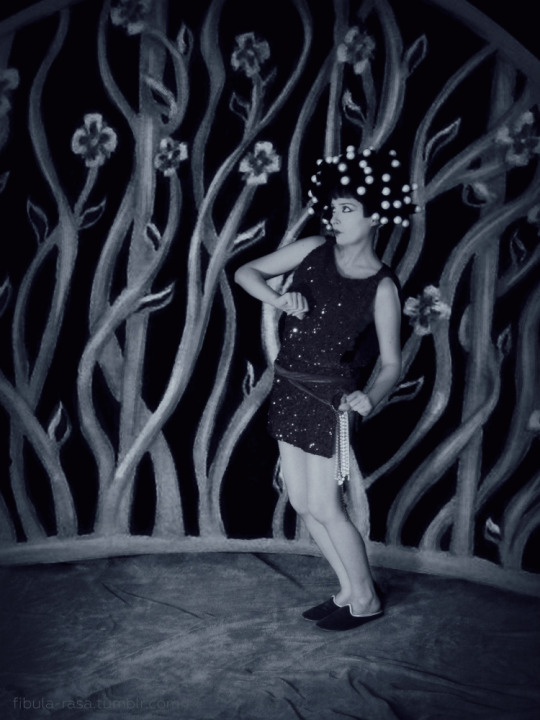
My cosplay of Nazimova as Salomé
Artists United? Allied Artists and the Release of Salomé
When Nazimova made her screen debut in War Brides (1916), the American film industry was undergoing a series of formative changes. Southern California became the center of professional filmmaking in the US—fleeing New Jersey (where War Brides was filmed) largely because of Thomas Edison’s attempts to monopolize the business. Preferences of audiences and exhibitors shifted away from one and two-reel films and towards feature-length films. The Star System emerged in full force. Nazimova soon relocated to Hollywood, signed a contract with Metro, and reaped the benefits of this boom period for American film artists.
The focus on feature-film production and the marketing of films based on the reputations of specific filmmakers or stars required a greater initial outlay of resources—time, money, and labor. But, it also paid dividends—the industry quickly grew into a big-money business. The underlying implication of that is that a larger share of the profits were shifted from the people doing the creating (artists and technicians) and towards other figures (capitalists). In practice, this also meant film companies would become eligible for listing on the stock exchange and could secure funding from banks and financial institutions, both of which were rare or impossible before the mid-1920s. The major players on the business end of production, distribution, and exhibition, therefore, wanted to consolidate their power and reduce the power and influence of the filmmakers.
To illustrate how momentous this handful of years was in the history of the US film industry, allow me to highlight a few key events. Will Hayes’ office was set up in 1922 to make official Hollywood’s commitment to self-censorship. Eastman Kodak introduced 16 mm film in 1923, a move which, while making filmmaking more accessible and affordable, also widened and formalized the division between the professional industry and amateur filmmaking. Dudley Murphy’s “visual symphony” Danse Macabre[1] was released in 1922—considered America’s first avant-garde film. Nazimova’s Salomé was considered America’s first art film from its initial release in 1923. That these labels were deemed relevant in this period illustrates the line being drawn between those films and film as a conventional, commercial product. The concept of art cinemas in the US was first proposed in 1922 spurring on the Little Cinema movement later in the decade.

from Danse Macabre

from Salomé
As any industry matures, both the roles within it and its output become more starkly delineated. That is to say that, as the US industry began differentiating between art/avant-garde/experimental film and commercial film, the jobs within professional filmmaking also became more firmly defined. Filmmaking has always been a collaborative art, but in the period prior to the 1920s, it was common for people in film to do a little of everything. As a result, what sparse credits made it onto the final film didn’t necessarily reflect all of the work that was done. To illustrate this using Nazimova,[2] at Metro, she had her own production unit under the Metro umbrella. While her films were “Nazimova Productions,” she didn’t have full creative control of her films. However, Nazimova did choose her own projects, develop said projects, and contribute to their writing, directing, and editing. When those films were released, aside from the “Nazimova Productions” banner, her only credit would usually be for her acting. Despite that impressive level of creative power, the studio still had the ultimate say on whether a film got made, and how it would be released. As studios grew and tightened control of their productions, this looser filmmaking style became much less common.
The structure of the industry at this time was roughly tripartite—production, distribution, and exhibition. Generally speaking, the way studio-made films traveled from studio to theatre—before full vertical integration—was that the production company would make available a slate of films of different scales. (Bigger productions with bigger names attached would have a special designation and come with higher rental fees.) Famous Players-Lasky was the biggest production house at the time, though other studios, like Metro, were quickly catching up. Distribution companies would then place this slate of films on regional exchanges, centered in the biggest cities in a given region. Exhibitors (this could be owners of chains like Loew’s in the Midwest and Northeast, the Saengers around the gulf coast, or individual theatre owners) could then rent films through their local exchanges. (This was an ever-shifting industry, so this process was not true for every single film. This is only meant as a quick overview of the system.) As the 1920s wore on, exhibitors began entering the production arena and producers further merged with distribution companies and exhibition chains. Merger-mania was the rule of the day.
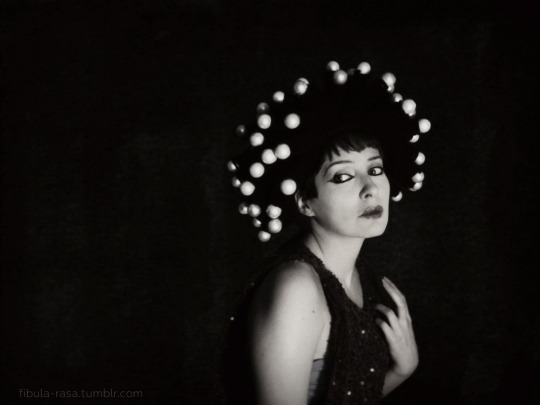
My cosplay of Nazimova as Salomé
As merger upon merger took place and a handful of businessmen tried to monopolize the industry, American filmmakers responded by championing the artistic legitimacy of filmmaking in the US. Leading this charge were the very filmmakers on whose backs the big business of film had been built. As noted in Tino T. Balio’s expansive history of United Artists, The Company Built by the Stars:
…Richard A. Rowland, president of Metro Pictures, proclaimed that ‘motion pictures must cease to be a game and become a business.’ What he wanted was to supplant the star system, which forced companies to compete for big names and pay out-of-this-world salaries for their services. Metro, he said, would thenceforth decline from ‘competitive bidding for billion-dollar stars’ and devote its energies to making big pictures based on ‘play value and excellence of production.’”
It’s notable for us that these ideas were espoused by Rowland, head of the studio where Nazimova was currently one of those “billion-dollar stars.” (“Billion-dollar” is obviously a massive overstatement.) It was a precarious time for any filmmaker who cared about the quality and artistry of their work. It was this environment that birthed United Artists, a new production company built around the prestige and reputation of its filmmakers, Douglas Fairbanks, Mary Pickford, Charlie Chaplin, and D.W. Griffith. As the statement announcing the formation of UA detailed:
“We also think that this step is positively and absolutely necessary to protect the great motion picture public from threatening combinations and trusts that would force upon them mediocre productions and machine-made entertainment.”
It’s an accurate assessment of industry trends at the time. If the desired product is a high-quality feature-length film, production is necessarily more expensive. As the UA statement intimates, monopolizing the entire industry and sacrificing quality for quantity to fill the exchanges and theatrical bills was the studio heads’ solution to rising costs. Not a great signal for filmmaking as art in America.
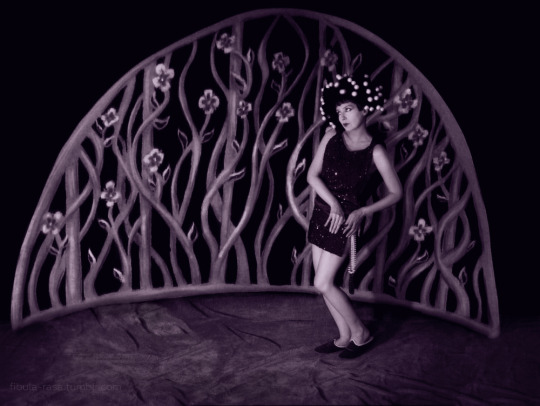
My cosplay of Nazimova as Salomé
So, Nazimova was in good company when she chose to go independent, believing in film as art and that American moviegoers deserved better than derivative, studio-conceived films. Some of the other artists who went independent included George Fitzmaurice (one of the most revered directors of the silent era, though most of his films are now sadly lost), Charles Ray, Max Linder, Norma Talmadge (in alliance with Sam Goldwyn), and Ferdinand Pinney Earle (whose massive mostly-lost artistic experiment Omar Khayyam, I profiled in LBnF). If these filmmakers shared the motivation of UA to create higher-calibre productions, where would the money come from? For Nazimova, the answer was her own bank account.
In 1922, Nazimova’s final film for Metro, Camille (1921), was still circulating widely due to the rising popularity of her co-star, Rudolph Valentino, after the release of Four Horsemen of the Apocalypse (1921) and The Sheik (1921). While Nazimova had the funds to complete A Doll’s House and Salomé, there was no sure bet for the films’ releases. Nazimova’s initial concept for her independent productions was the “repertoire” film. This scheme would have seen A Doll’s House released as a shorter film with Salomé as a feature and the two could be rented as a package by exhibitors. It was a creative response to growing tensions between producers and exhibitors over a practice called block booking. Block booking was a strategy studios employed to leverage the Star System to its fullest. They would take the most in-demand films associated with the biggest drawing stars and only make them available in a package deal with productions that were perceived as less marketable. Nazimova was aware that her films at Metro had been rented this way (as the special feature). It’s not completely clear from my research if the decision to release Salomé and A Doll’s House as two features was creative, practical, or a combination of the two. The “repertoire” concept may not have gone according to plan, but it was an early indication that Nazimova was well-informed of the nuances of distribution and exhibition.
Nazimova’s need for proper distribution was met by United Artists’ distribution subsidiary, Allied Artists. United Artists’ first few years were a struggle. Fairbanks, Pickford, and Griffith[3] needed significant time and money to finish the high-quality productions that they promised and Allied was their solution. This distribution arm would release the work of other independent talent using the same exchanges as UA, but under a different banner. Though Allied used UA’s exchanges for distribution, the subsidiary had its own staff. Allied having different branding would also protect the prestige of the UA name. (An unkind, but not entirely inaccurate summary: the money your work brings in is good enough for us, but your work is not.) Allied would have a full release slate to generate the revenue that UA needed to remain in operation.
Nazimova was one of the filmmakers who signed a distribution deal with Allied and had reason to regret it—though she and Charles Bryant didn’t openly rag on UA/Allied.[4] Notably, Mack Sennett had arranged the release of Suzanna (1923) through Allied and was vocal about the company bungling its release. Differences over distribution and exhibition would also lead to Griffith’s exit from the company and a major rift between Chaplin and Pickford-Fairbanks. After 1923, Allied reduced its operation, at least in part because of the bad reputation they were garnering with other filmmakers. Despite numerous independents losing money on productions released through Allied, by 1923, Allied had netted UA 51 million dollars in revenue!
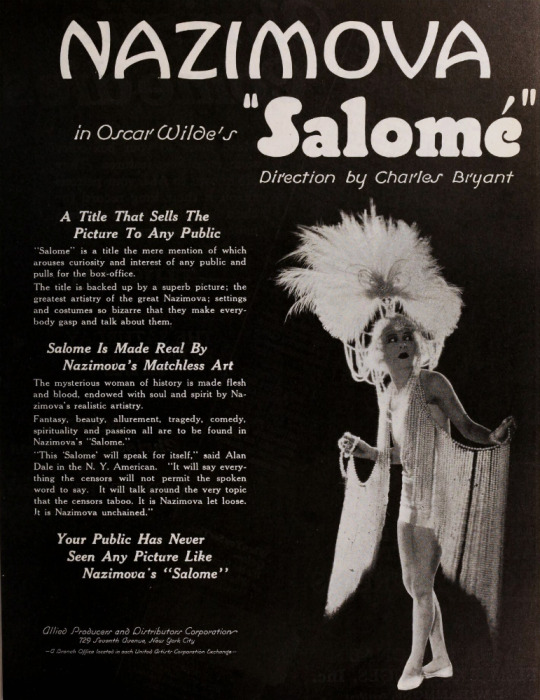
Trade ad for Salomé from Motion Picture News, 10 March 1923
The questionable deals that these independent filmmakers received with Allied are often mentioned in discourse about the period, but very, very rarely does anyone offer details of what Allied’s inadequate distribution looked like. Using the information available to me via Lantern, I collected and analyzed data regarding the release and exhibition of Nazimova’s final two Metro films and both of her Allied films.[5] Looking at the trade publications Exhibitor’s Trade Review, Moving Picture World, Motion Picture News, and Exhibitors Herald, I categorized every item I found about the release or exhibition of Billions (1920),[6] Camille, A Doll’s House, and Salomé. The “release” items are primarily advertisements, reviews, and news items about release dates or pre-release screenings. The number of these items for all four films were comparable.
The items in the “exhibition” category, however, reveal a marked difference between the Metro and Allied releases. This category includes items like first-run theatre listings, exhibitor feedback, and advertising advice for theatre owners. Only counting exhibition items from the first two years (24 months) from the initial release of each film, Billions and Camille had twice as many items as A Doll’s House and Salomé!
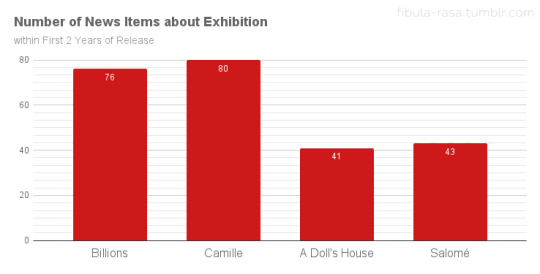
While this isn’t necessarily hard data on how many theatres ran each film, it is a rough indicator of how well the films circulated. This data suggests that neither A Doll’s House or Salomé had distribution comparable to the Metro films. In order to compensate for the Rudy factor—Valentino’s major rise to stardom in 1921—which could have affected Camille’s numbers in a big way, I included Billions as well. Billions was sold as a special (a bigger production with premium rental fees) on Nazimova’s name alone. It was not especially well received. Exhibitors/theatre owners had mixed feelings on the film because Nazimova’s previous film, Madame Peacock (1920), had underperformed. Many exhibitors viewed Billions as an improvement, though it still did not meet their perception of Nazimova’s standard of quality. Despite that, Billions had 76 exhibition-related items across its first 24 months of availability to Camille’s 80.
To get a little deeper into this data, I wanted to see how the feedback from exhibitors and theatre owners compared. I broke down the exhibitor feedback for each film as positive, middling, or negative based on how the exhibitors assessed audience response and/or box office receipts. (I discounted feedback that only reflected theatre owners’ own personal assessment of the films without mention of their patrons or receipts.) Positive feedback could be good reception and/or good receipts, middling suggests only average business and no noteworthy reception, and negative indicates poor response and/or poor ticket sales. Since there are so many more items about Camille and Billions than A Doll’s House and Salomé, I compared ratios as an indicator of exhibitor satisfaction. The results were truly surprising.
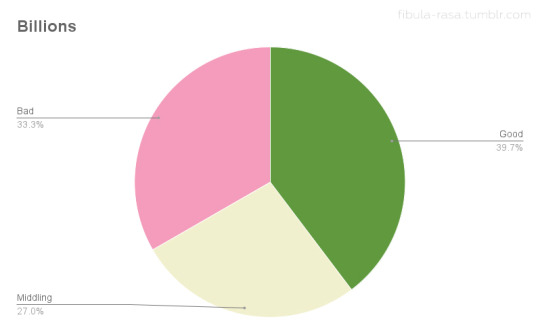
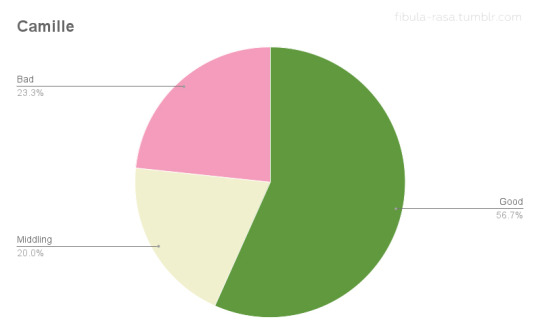
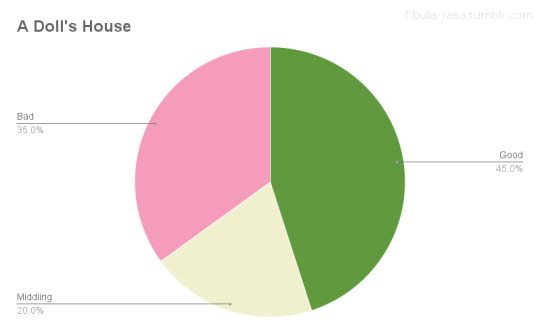
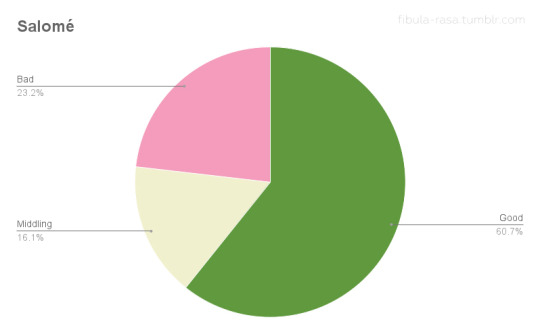
Theatre owners who rented Salomé may have been in significantly smaller numbers than those who ran Camille, but their satisfaction with ticket sales and audience feedback was roughly equivalent. (Though slightly more positive for Salomé!) The numbers for Billions line up with the qualitative assessment I summarized above, displaying a roughly equal 3-way split. A Doll’s House was the most divisive with the highest proportion of negative feedback of the four films, yet with a higher proportion of positive feedback than Billions.
Taking all of this into account, it’s clear that Salomé did not flop because it was too artsy or esoteric for the American moviegoing public. Such assumptions are obviously not very thoughtful or informed by reliable data.[7] A more historically sound reading is that, as professional filmmaking matured into a “legitimate” industry in the US, the various arms of the business were rigidly formed to fit conventional output. The conservatism that this engendered made the American industry ill-equipped at marketing anything too unconventional or experimental. While Hollywood insiders were lamenting European filmmakers artistically outdoing Americans—especially following the US release of The Cabinet of Dr. Caligari (1920)—very few people with the power to shape the industry did anything to support experimentation. Given this environment, Salomé could only have been produced independently, but the quickly ossifying distribution and promotional systems didn’t have the range to give it a proper release. Two films contemporary to Salomé, Beggar on Horseback (1925) and The Old Swimmin’ Hole (1921) offer further evidence of the industry’s limitations.
The Old Swimmin’ Hole is a feature-length production by Charles Ray, experimental in that it uses no intertitles. The story is simple and familiar with Ray playing the Huck-Finn-type character he was well known for. Ray’s experiment was not an expensive one and the film was successful. However, decision makers at First National, the film’s distributors, felt that The Old Swimmin’ Hole was simply too complex for small-town Americans to comprehend and it wasn’t released outside of cities. To put it plainly, the distributor’s unfounded concept of ignorant yokels meant that a film about country living was largely inaccessible to anyone actually living in the country. Though the film was well received and turned a profit, this distribution decision likely limited its audience as well as possible revenue from small-town exhibition.
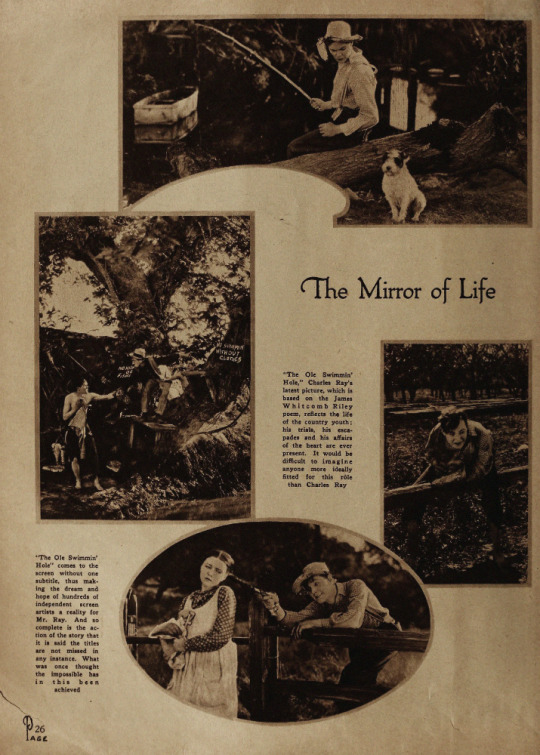
Stills from The Old Swimmin’ Hole from Motion Picture Magazine, April 1921
Beggar on Horseback was produced by one of the biggest studios in Hollywood, Famous Players-Lasky, and distributed by Paramount. Starring comedian Edward Everett Horton, Beggar was an expressionist comedy based on a popular play. The film had a popular star, popular source material, and was made and released by a major company, but Beggar was apparently too unconventional for that major company to adequately market it. (Unfortunately, only a few minutes of the film survive, so we can’t fully reassess it unless more is found/identified!)
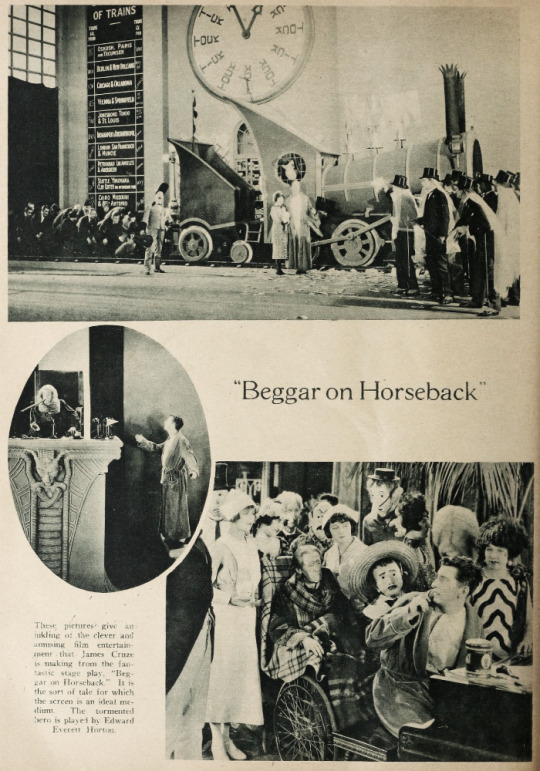
Stills from Beggar on Horseback from Picture-Play Magazine, August 1925
With all these complicating factors at play, how might have Salomé found its audience in 1922-3? Nazimova and Charles Bryant had innovative ideas for the film’s release that might have done the trick, if they had been able to act on them. Nazimova and Sam Zimbalist had finished cutting Salomé in late-spring 1922. Having spent practically all of her money to finish the film, and following A Doll’s House’s disappointing results, Nazimova was eager for Salomé to hit theatres. Though the film was in the can and private preview screenings had been held by Bryant by summer ‘22, Salomé wouldn’t be released until February of 1923. In studio filmmaking, holding a film in extended abeyance wasn’t ideal but it was not disastrous. Studios had significantly more resources and revenue streams than independent producers. If, for example, the release of Billions had been delayed for seven months, Nazimova still had two films on the Metro exchanges (and therefore in theatres) and Camille would have entered production in the meantime. But for Nazimova as an independent producer, this situation was wholly untenable. (In fact, Pickford, Fairbanks, and Griffith were in a similar untenable situation when they founded Allied.)
Initially, Bryant proposed roadshowing Salomé. Roadshowing is a release strategy for notable film productions where a film is toured around major cities, often with in-person engagements by stars, writers, and/or directors. Nazimova expanded the idea of touring with Salomé not simply as a roadshow, but paired with a short play in which she would star. Double the Alla, double the fun. As far as I can tell, there isn’t publicly available information about why Salomé wasn’t roadshowed. However, we do know that Griffith, as the only non-performer in UA, wanted to utilize different approaches for the release of his films—like roadshowing—and it became one of the major points of disagreement with his fellow UA decision makers. That could be taken as an indication that something similar might have occurred with Nazimova and Allied.
As time dragged on without a release date for Salomé and Nazimova returned to theatrical work—openly admitting to audiences that she was broke—Bryant took matters into his own hands. At the end of December 1922, Bryant negotiated with the owner of the Criterion Theatre in New York City for Salomé to run on New Year’s as a special presentation. In two days, Salomé grossed $2,630, setting records for the theatre. Adjusted for inflation, that’s $48,988.96. It was successful enough that the owner of the Criterion opted to hold the film over. This bold move must have lit a fire under Allied’s tuckuses, as Salomé finally had its first-run release a little over a month later.
In the 1920s, the first-run booking of a film was a crucial part of its further success. Concurrent nationwide release of films wasn’t the norm yet, and if a film was a big production, getting booked at high-capacity motion picture houses in major cities was a necessity. These big city releases would, in theory, generate interest in the film with exhibitors across the country and internationally. Basically, if you spent a lot on a movie but couldn’t land a first-run release, you weren’t likely to turn a profit or even break even. Salomé had a handful of first-run bookings and local reviewers from those cities believed the film would succeed. A reviewer from the Boston Transcript in February 1923 wrote:
“…this newest Salome is something far better than a photographed play. Considered both as picture acting, and as an interesting experiment in design, “Salome” is a notable production. It will have a far and wide reaching influence on future films in this country.”
But, as I mentioned, only a handful of first-run theatres played Salomé, and, taken collectively, the notices I analyzed from contemporary trades imply that it didn’t gain traction once it was made available beyond its initial run.

My cosplay of Nazimova as Salomé
During this regrettably short theatrical run, exhibitors and reviewers from trade publications advised that Salomé was a unique film that called for unique promotion. The overall assumption was that theatre owners knew their patrons and recognised whether out-of-the-ordinary movies were popular with them. Rather than purely judging a film’s quality, exhibitors and trade reviewers had concerns specific to exhibition when providing feedback. These concerns cannot be overlooked if you want to understand their assessments. For example, exhibitor feedback was very often informed by how high the rental fees were for a film, even if exhibitors don’t directly mention said fees. That is to say, a mediocre film might be rated highly if the rental fees were modest (and if block booking wasn’t an issue). Reviewers in the early 1920s, both for popular magazines and trade publications, were already accustomed to the formulaic nature of most studio output. Their reviews commonly expressed fatigue with studio films’ lack of originality. And, perhaps surprisingly, this sentiment was shared among theatre owners as well—particularly when a run-of-the-mill film was sold to them as anything other than a “programmer” (a precursor to B-movies).
What I have learned, not just by analyzing feedback for Salomé, but also for all of the films in my LBnF series, is that when a 1920s reviewer calls out bizarreness in a film, it’s not always a negative quality, even when the review isn’t positive. In the case of reviews written for exhibitors/theatre owners, focussing on what makes a movie different is purely pragmatic. It guides how exhibitors might market films to patrons and helps exhibitors judge if a film would be suitable for their audiences. And, from that same research, I’ve found significant indications there were numerous markets throughout the US that were hungry for novelty—contrary to what studio apparatchiks wanted to admit. So, pointing out Salomé’s bizarreness was a recommendation for those markets to consider renting it as much as it was a warning against renting for theatre owners who only had success with more conventional films.
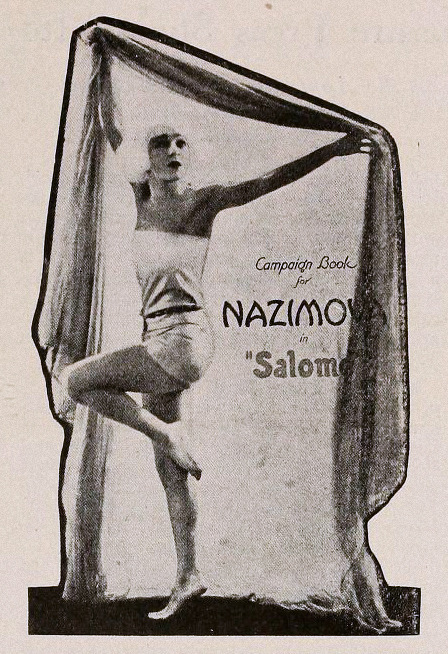
Cover of the Campaign Book for Salomé reproduced in Exhibitors Herald, 9 February 1924
In the case of Salomé, reviews and feedback upon its release focused on two major points:
The film isn’t “adult” in nature. Well-known productions of Strauss’ opera and the 1918 Theda Bara film of the same name led to a presumption of salaciousness. (I talked a bit about that in Part One!)
The film deserves/requires a build up as an artistic event film.
Nazimova’s company helped exhibitors with the latter point in a few ways. The company provided Aubrey Beardsley inspired art posters conceived by Natacha Rambova and executed by Eugene Gise. They printed a book to guide promotion of an artistic spectacle. (So far, I haven’t been able to find a physical or digital copy, so I can’t assess how good the advice was!) Salomé was also distributed with an official musical score, apparently written for a full orchestra.
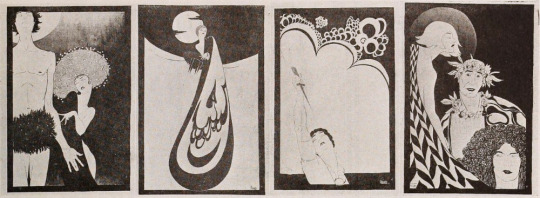
Art Posters designed by Rambova and painted by Gise as reproduced in Exhibitor’s Trade Review, 10 February 1923
The exhibitors who ran Salomé—and put at least some of this advice into practice—were satisfied with the business it did. By these accounts, the American moviegoing public was attracted by the novelty of Salomé, but what chance were they given to see it?
While this evidence of Allied’s poor distribution work may be circumstantial, it certainly complicates the narratives that Salomé was an unqualified flop or that average Americans weren’t (or aren’t) receptive to artistic experimentation. Given that Nazimova was not the only independent filmmaker who suffered from Allied’s inept distribution, it does seem like the underwhelming business Salomé did was due more to a poor choice of business partners than to any quality of the film or of American moviegoers. That said, with the increasing monopolization of the industry, Nazimova did not have a wealth of options.
Though Salomé was made and released at an tumultuous period for the US film industry, it did eventually find its audience through circulation in art cinemas. As the gap between experimental/avant-garde film widened in the US and the professional industry became less and less tolerant of departures from convention, Americans concerned with film as an art form rallied around amateur filmmaking clubs and art cinemas began popping up in cities by the middle of the decade. Salomé played in these theatres even after the advent of sound—occasionally even today. This is likely the key reason that Salomé survives and we’ve been able to continue to enjoy and reevaluate it one hundred years later.
Salomé is a significant film made at a significant moment in American film history. Nazimova took a major risk in going independent and personally funding two artistic projects. These films were founded on the beliefs that American moviegoers wanted art made by human beings with unique imaginations, feelings, sensibilities and that there was an audience for more than derivative, “machine-made” film. In my opinion, through close analysis of the circumstances of Salomé‘s release, we can see that Nazimova was likely correct, but didn’t get a genuine chance to prove it in her lifetime. Additionally, it’s important to note that Nazimova’s risks did not “ruin” her as is occasionally said. The state of her finances were more greatly affected in the 1920s by her fake husband’s habit of spending her money and by getting swindled by a pair of con artists over her estate, The Garden of Alla. Soldiering on, Nazimova continued to work in both theatre and film for the rest of her life and found more stability with the partner she would meet at the end of the 1920s, Glesca Marshall.
——— ——— ———
Once I finished this “Cosplay the Classics” entry, I realized that it would way too much for me to include a section on another relevant topic to Salomé: Orientalism in Hollywood. But, I feel that the topic is too important to just edit that writing out. Look out for a shorter “postscript” entry soon!
——— ——— ———
☕Appreciate my work? Buy me a coffee! ☕
——— ——— ———
Footnotes:
[1] Danse Macabre is also thought to be a major influence on Walt Disney animating to music, as seen in “Silly Symphonies” and later Fantasia (1940) and Disney’s other musical anthology features. It was also in this period that Disney fled from his debtors in the Midwest to California with his first “Alice” movie. However, the wide-ranging effects of Disney’s business practices were not felt until much later, so that’s another story for another time!
[2] Nazimova was one of a handful of women in Hollywood at the time who held significant creative power. June Mathis and Natacha Rambova, both of whom Nazimova regularly worked with, Mary Pickford and her regular tag-team partner Frances Marion are among some of the others.
[3] Chaplin wouldn’t produce a film for UA until 1923’s A Woman of Paris, as he was fulfilling a pre-existing contract with another studio.
[4] According to Gavin Lambert’s biography of Nazimova (which I discussed as a largely unreliable source in Part One), Robert Florey supposedly advised Nazimova against signing with them, citing Max Linder and Charles Ray as artists who had been “ruined” by their deals. However, the timeline does not quite match up. Though Florey did visit the set of Salomé, Nazimova had already signed the Allied deal by then and Ray had not finished The Courtship of Miles Standish (1923) when Salomé was in production. In fact, there was almost a year and a half between the completion of Salomé and the release of Standish. Whether this was a lapse of memory by Florey or misreporting by Lambert, I can’t be sure.
[5] Originally, I wanted to include Madonna of the Streets (1924) in my comparisons but, at the moment, Lantern has gaps in their Moving Picture World archive for 1924-5. I didn’t want to draw conclusions from incomplete data.
[6] Billions was also a Rambova-Nazimova collaboration. Rambova designed a fantasy sequence for the film.
[7] A mindset that’s still common among commercial media outlets today unfortunately. I could rant and rant about “content” and “content creation” all day but that’s another story for another time.
——— ——— ———
Bibliography/Further Reading
(This isn’t an exhaustive list, but covers what’s most relevant to the essay above!)
Lost, but Not Forgotten: A Doll’s House (1922)
“Nazimova in Repertoire” in Motion Picture News, 29 October 1921
“Alla Nazimova Plans for Her New Pictures” in Moving Picture World, 29 October 1921
“Nazimova Abandons Dual Program for Latest Film” in Exhibitors Herald, 24 December 1921
“Plays and Players”in Photoplay, February 1922
“PICTORIAL SECTION” in Exhibitors Herald, 4 February 1922
“New Nazimova Film May Be Roadshowed“ in Exhibitors Herald, 15 April 1922
“Newspaper Opinions” in The Film Daily, 3 January 1923
“Splendid Production Values But No Kick in Nazimova’s ‘Salome’” in The Film Daily, 7 January 1923
“Claims “Salome” Hit New Mark at N. Y. Criterion” in Exhibitors Herald, 27 January 1923
“Salome” in Exhibitors Trade Review, 20 January 1923
“Nazimova in SALOME” in Exhibitors Herald, 27 January 1923
“Nazimova Appeals To Exhibitors In Behalf of ‘Salome’” in Exhibitor’s Trade Review, 27 January 1923
“Novelty Features Paper and Ads for ‘Salome’” in Exhibitor’s Trade Review, 10 February 1923
“SALOME’ —Class AA” from Screen Opinions, 15 February 1923
Nazimova: A Biography by Gavin Lambert (Note: I do not recommend this without caveat even though it’s the only monograph biography of Nazimova. Lambert did a commendable amount of research but his presentation of that research is ruined by misrepresentations, factual errors, and a general tendency to make unfounded assumptions about Nazimova’s motivations and personal feelings.)
Lovers of Cinema: The First American Avant-Garde 1919-1945 ed. Jan-Christopher Horak (most notably, “The First American Avant-Garde 1919-1945” by Horak, “The Limits of Experimentation in Hollywood” by Kristin Thompson, and “Startling Angles: Amateur Film and the Early Avant-Garde” by Patricia R. Zimmermann)
United Artists: The Company Built by the Stars, Vol. 1 1919-1950 by Tino Balio
#1920s#1922#Salomé#salome#nazimova#alla nazimova#film history#cosplay#queer film#silent era#classic movies#film#avant garde#experimental film#cinema#queer film history#silent cinema#1923#classic cinema#american film#women filmmakers#women in film#silent film#classic film#silent movies#bisexual visibility#cosplayers#natacha rambova#united artists#Metro
36 notes
·
View notes
Text
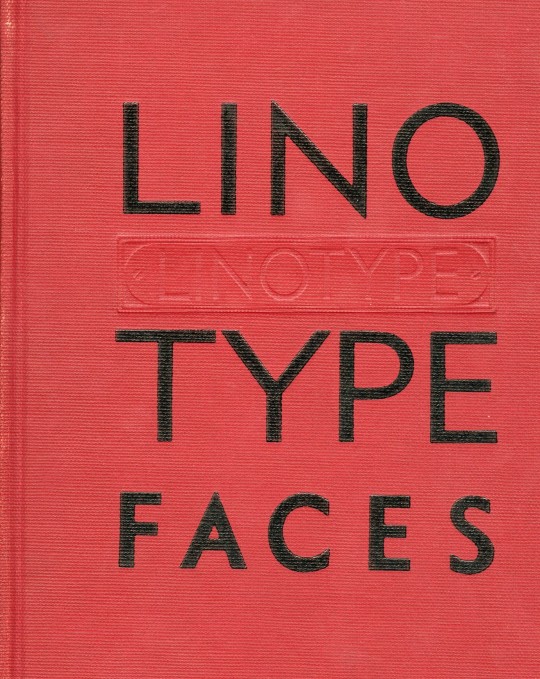
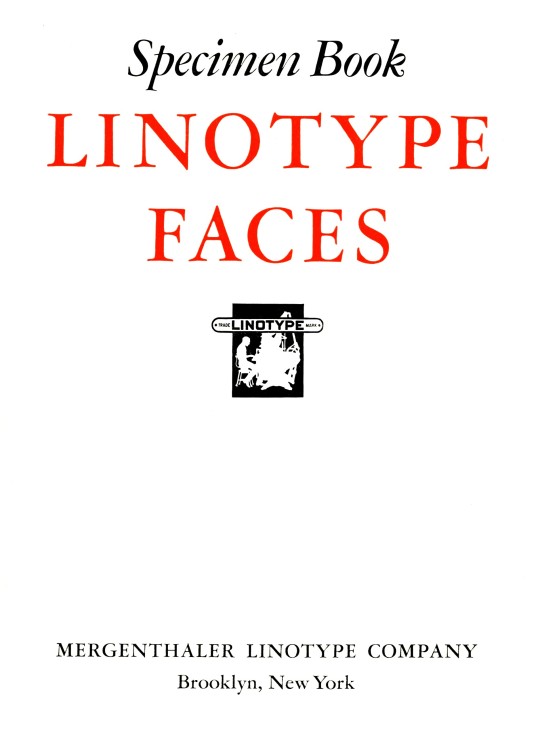
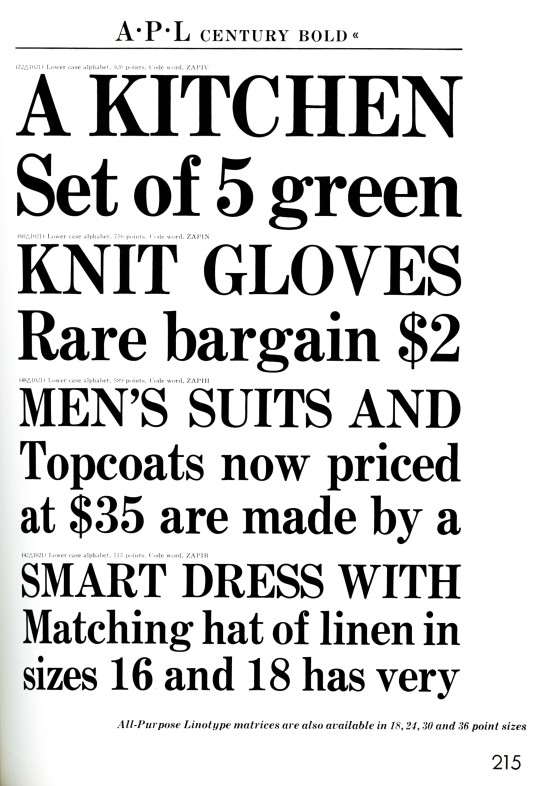


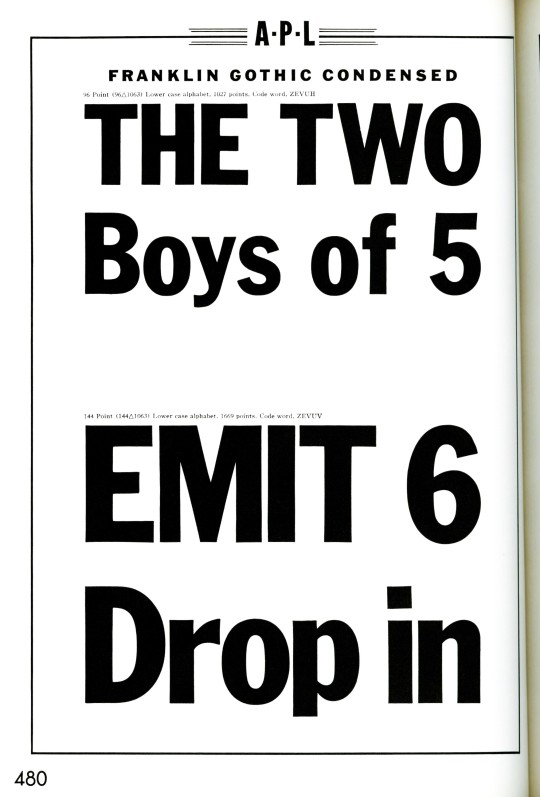

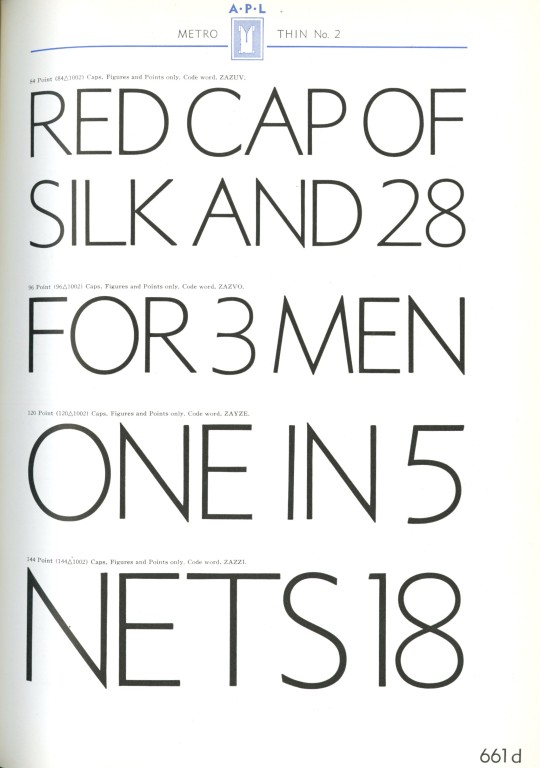

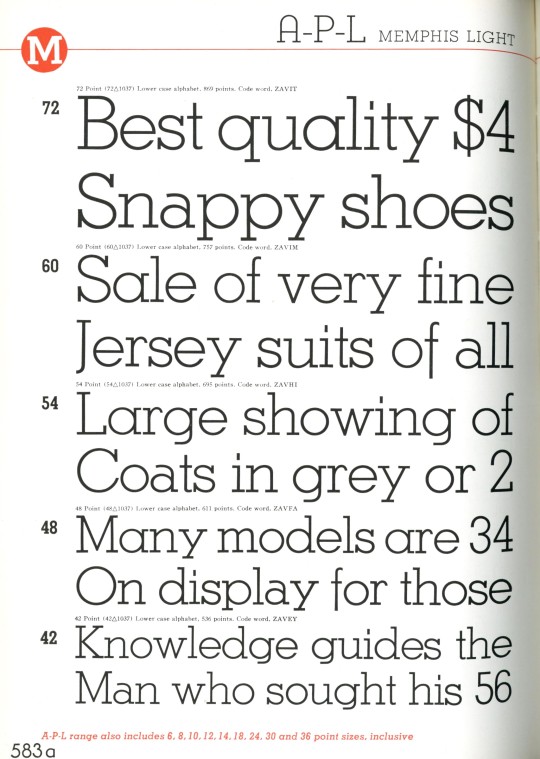


Typography Tuesday
Before the holidays on December 16, the Milwaukee Public Library held its third Art Book Club session, a informal art book appreciation gathering that meets once a month in the Art, Music, and Recreation Department of the Central Library. The theme for this meeting was "Technology" and there were all manner of beautifully-designed technology books to peruse and ogle over. It was an immersive experience, and of course I was particularly pleased to spend time with the type specimen books.
This week I highlight one of those books, Specimen Book Linotype Faces, published in Brooklyn, New York by the Mergenthaler Linotype Company in 1939. The typefaces displayed here are:
Century Bold, designed by Milwaukee-born Morris Fuller Benton in 1900.
Gothic No. 13, by Morris Fuller Benton ca. 1900.
Franklin Gothic, designed by Benton in 1903.
Metro Light, designed by W. A. Dwiggins in the early 1930s.
Garamond No. 3, originally designed for American Type Founders by Morris Fuller Benton in the late 1910s and licensed to Linotype's American branch around 1936.
Memphis, originally designed for the Stempel Type Foundry by Rudolf Wolf in 1929.
View other type specimen books.
View more Typography Tuesday posts.
-- MAX, Head, Special Collections
#Typography Tuesday#typetuesday#Linotype Faces#Mergenthaler Linotype Company#Century type#Gothic No. 13#Franklin Gothic#Metro type#Garamond#Memphis type#20th century type#Milwaukee Public Library#Art Book Club#Morris Fuller Benton#W. A. Dwiggins#Rudolf Wolf
68 notes
·
View notes
Text
WEMU: Author Veronica Johnson is capturing the stories of jazz women from Detroit
John Bommarito spoke to author Veronica Johnson about her oral history project about women in Detroit jazz on his program The Song Break.
TRANSCRIPTION:
John Bommarito: My guest on the Song Break today is a Detroit-based journalist and oral historian who is, in addition to her regular writing duties, working on something WEMU listeners will certainly be interested in knowing more about a project documenting woman in jazz music--Detroit Women in jazz music specifically. Welcome, Veronica Johnson, to the WEMU airwaves. How are you today?
Veronica Johnson: I'm good. Thanks for having me, John.
John Bommarito: It is my pleasure. Tell me a little bit about yourself. Where did you grow up?
Veronica Johnson So, I'm born and raised in Detroit, Michigan. Currently, I live in Redford, Michigan, which is just outside of Detroit. But, yeah, born and raised, west side of Detroit. So, I'm Detroit through and through.
John Bommarito: Very good. And what was on the radio when your parents were in charge of the dial versus when you took control?
Veronica Johnson: Well, I mean, my mom, she really loved my old school music. So, you know, I grew up being in a car listening to, like, the Isley Brothers or Earth, Wind and Fire, all of that. So, I'm definitely I think there are was also old soul. So, I've been listening to, like, that older R&B type of music all my life.
John Bommarito: Sure.
Veronica Johnson: And that's why I think I have definitely a great appreciation for it now, but I didn't really get into jazz until I got to college. I'm a minor with the music, and I took a music history course. It was on jazz, so it was just so much about the music that I didn't know. I was just like, "Wow!" you know, I heard of Miles Davis, John Coltrane, but just kind of really digging deep into their music and how much of an impact they had on the genre, as well as other genres as well. So, yeah, I just kind of got hooked on jazz music after that. And my major was actually in journalism, so I kind of fused my two passions together. So, that's kind of how I ended up writing about jazz music.
John Bommarito: Who got you interested in writing? Was there a particular author that inspired you?
Veronica Johnson: Well, actually, when I was younger, I started I kind of writing poetry. So, like, my grandmother, she was like a big inspiration on me. She wasn't a writer, but she kind of always championed my work. And, you know, I always would write different poems like that. And she always used to like to brag to her friends and have me read it aloud. So, I kind of started out writing poetry. But when I got in high school, I took a journalism class, and I realized I really kind of liked that art form and platform being able to kind of let people know what's going on. So, I definitely kind of started down the path of going into journalism after taking some courses in high school, and then I majored in it in college.
John Bommarito: My guest today on the Song Break is author Veronica Johnson, working on a project documenting Detroit women in jazz music. When did you start this project, and what was really your inspiration for starting? You just felt like Detroit needed a highlight?
Veronica Johnson: I mean, I've been covering jazz artists for a while on different outlets, but I'd say getting more into jazz and particularly learning more about Detroit jazz. I actually want to give a shoutout to my mentors like Charles Latimer. And he's a Detroit writer, Metro time jazz writer, and also Jim Gallert and Lars Bjorn. They actually wrote a book about Detroit jazz called "Before Motown: A History of Jazz in Detroit." So, just learning more about Detroit jazz and, obviously, so many obviously great male musicians from Detroit, likeMarcus Belgrave, Ron Carter, Paul Chambers, people like that. But, obviously, I was like, "Where's the female musicians? I know they're here." And I just really wanted to dig more deep into that. And I did a lot of research. You know, there's musicians that had a great impact on Detroit, like Terry Pollard, the great piano player. Alice Coltrane, obviously, everybody knows her being there with John Coltrane. She's from Detroit. She was a great piano player and harpist. So, yeah, I just really started digging deep into more on Detroit jazz. And I was just like, "I want to give a platform to these woman musicians. They're making just as much of an impact as male musicians, but I don't see a whole lot of them." And if I do, I don't see a lot written about them. So, I kind of just started on path, actually. My first interview was in 2018. I interviewed a musician named Carol McKinney. She's actually part of the--everybody knows--the McKinney kind of family, you know? Dalen, who's a great drummer from here in Detroit. This is her aunt. She's actually a saxophone player. So, I started playing at Bert one time, and I was just like, "Who is that? I really want to know about you. I don't see a whole lot of female saxophone players either."
John Bommarito: No.
Veronica Johnson: So, I actually did my first interview back in 2018. So, from there, I just kind of started musicians who I was familiar with. I've interviewed a lot of vocalists, a lot of piano players. Obviously, this kind of almost doesn't really have an end to it because there's so many female musicians that are doing so much great work here in Detroit and metro Detroit. Yeah, I've got about 21 interviews under my belt so far.
John Bommarito: Who have been some of the favorites that you've done so far?
Veronica Johnson: Well, I mean, everybody I think is special about this. Everybody has just, like, their own unique story. So, my thing is I just love hearing how they got started and things like that. I have the same questions like, "How did you get started in music and all that?" I guess if I just had to pick, I mean, like I've interviewed just about everybody from straight ahead. So, like, Mary Hayden--she's awesome. I got to mention Gaelynn McKinney. Mickey Braden, Elena Moore. So, those, I guess are some of the ones that have been really memorable. But, again, just musicians that are doing really great work. But, again, you don't hear about a lot of. A musician named Taslim Abay--she's a really amazing stride piano player. She had a really amazing story. I've interviewed a lot of vocalists--Ursula Walker, she's amazing. I interviewed her back in 2019. Those are the few that come to mind, but everybody I've interviewed definitely has a unique story.
John Bommarito: Who is still on the wish list? And how are you tracking these people down?
Veronica Johnson: Yeah, a lot of it, I mean, thankfully, I've connected a lot with musicians. When I do an interview, I'll say, "Hey, who do you think I should interview next?" or X-Y-Z. I'm going to get tons of names of different musicians, but definitely actually is next on my list. I've been doing a lot of local musicians, but I've actually would like to interview some people, obviously, that are like super national, like Regina Carter. I had an opportunity to interview her last year about the Detroit Jazz Fest when she was given the NEA jazz Masters and all that. But, obviously, she's from Detroit. So, even though she's obviously had a larger platform, but I definitely want to add her to the list. She's on there. Sheila Jordan is another one. You know, obviously, she's, I think, in her 90s, but she's from Detroit. So, I definitely want to get her story as well. So, yeah, I got a lot more to go obviously. But those are just a couple that I definitely want to get to sooner than later.
John Bommarito: Looking forward to when we were going to be able to consume this. When is it going to be able to be seen by the public?
Veronica Johnson: So, I'm actually working with a grassroots organization here in Detroit called The Detroit Sound Conservancy. I used to be a board member. I've been a part of it for a long time. So, they're really passionate about making sure that Detroit music is preserved. And they actually doing a lot of work at their store in actually the Bluebird Inn, which was a famous club back in like the 40s and 50s. They actually own the building now. And they're restoring it and turning into an archival location for Detroit music and things like that, so, working with them, trying to get it out there. I've worked with a couple of organizations who really anchor now with the Detroit Sound Conservancy. So, I'm hoping toget everything digitized. Everything obviously has been recorded, but just working with them to get everything digitized. And then, hopefully, my goal is to have everything--at least the interviews I've done so far--out there by next year. And, my goal is to work with BFC to do an exhibit. I would love to work with these musicians to, again, just have a place where they can go with the platform they have or other people that aren't familiar or may not be familiar with their music can go and learn more about them. And, you can check out their oral histories and all that. So, that's just a couple of things I have to work on.
John Bommarito: On the Song Break today, we're chatting with Veronica Johnson. Veronica, thanks for taking the time to explain what you're working on. And where can people find out more about you in particular at this point--about your writing and the things you've done so far?
Veronica Johnson: So, I do freelancing for a couple of publications: Metro Times, some stuff with them, Moderately Media. Also, I write monthly jazz reviews, album reviews for Downbeat, doing some stuff with them, hopefully doing some features soon as well. So, yeah, obviously, people can get in touch with me on Facebook as well. If there's, again, any musicians out there--female musicians--that you think I should be getting their story, definitely feel free to reach out to me on social media.
John Bommarito: I also found Roots Rhythm and Rhyme.WordPress.com is a place to find out some of your previous work, so I don't know if you're embarrassed by that. You shouldn't be, but that's a good resource as well. Roots Rhythm and Rhyme.WordPress.com. Check that out. Thank you so much for your time, Veronica. Good luck with the project. We look forward to seeing it when it's all finished and ready to go.
Veronica Johnson: Thanks for having me, John.
John Bommarito: My pleasure. Music from one of the artists you've spoken to up next. Joan Belgrave was on that list of people you sent me, so we're going to get something from her album "Excitable" right now on the Song Break on 89 one WEMU.
#Author Veronica Johnson is capturing the stories of jazz women from Detroit#Jazz#Detroit#Black Music#Veronica Johnson
17 notes
·
View notes
Text
The host city for the DNC is Chicago, whose metro area is home to more Palestinian Americans than anywhere else in the country. But you would not know this looking at that stage. Despite the appeals of Palestinian American delegates and activists, no Palestinian American is scheduled to address the convention from the main stage. I suspect this is because of what such a speaker might feel compelled to say. In response to the massacre perpetrated by Hamas last October, the state of Israel has killed some 40,000 Palestinian people. The intention behind this carnage has been declared openly. “We are fighting human animals,” Israeli Defense Minister Yoav Gallant has said. “And we are acting accordingly.” Acting accordingly has meant the erasing of roughly two percent of the entire population of the Gaza Strip, a fact not to be mourned since, according to Israeli President Isaac Herzog, “There are no innocent civilians in Gaza.”
The most destructive bombs that have actualized this rhetoric of extermination are being furnished by America, and more specifically, by the head of the Democratic party. In February, as President Joe Biden sought to seal the nomination from that party, activists in Michigan rallied registering voters in the state to check “uncommitted” as a protest against the Biden administration’s backing of the war. The campaign garnered 13 percent of the vote and quickly spread to other states. By Democratic party rules, this entitled the Uncommitted movement to 29 delegates, who are here in Chicago to press their case against what has been labeled, convincingly I might add, a genocide.
....
This is a formulation that depends on seeing Palestinians, and Palestinian life, with the same clarity as all other human life. One way this clarity and equality is expressed in our society is through our arts, our media, our public rituals—rituals like national political conventions. Maybe more than in any other year, this DNC has urged its various constituencies to highlight their identities and the collective pain that animates them. Racism, forced birth, land theft. It has been an exhibition of what the Palestinian scholar Edward Said called “the permission to narrate,” and it is that permission that Palestinian Americans have been denied. They have heard their names mentioned fleetingly by a handful of speakers but have not been granted the right to speak their names themselves. Perhaps that is for fear of what else a Palestinian American speaker might name. I cannot say that fear is unwarranted.
#palestine#free palestine#gaza#isreal#genocide#colonization#apartheid#us politics#american imperialism#settler colonialism
7 notes
·
View notes
Text
The Rising Real Estate Landscape in Noida: A Closer Look at Top Commercial Projects

Noida, one of India's fastest-growing commercial hubs, has emerged as a preferred destination for businesses, entrepreneurs, and investors. With its well-planned infrastructure, connectivity, and strategic location, Noida has become a magnet for top commercial real estate developments. Among the standout projects contributing to Noida's growth are CRC The Flagship, Fairfox EON - Eye Of Noida, and Splendor Onyx Blue, all of which are located in the thriving Sector 142 of Noida.
Sector 142 Noida: The Emerging Business Hub
Sector 142 in Noida is rapidly transforming into a bustling business district, offering a perfect blend of office spaces, retail centers, and connectivity. Its proximity to the Noida-Greater Noida Expressway makes it an attractive location for businesses looking to establish their presence in a well-connected and thriving environment.
CRC The Flagship: Redefining Commercial Spaces
CRC The Flagship is one of the most talked-about commercial projects in Noida, designed to provide world-class amenities and state-of-the-art infrastructure for businesses. This project is known for its futuristic design, eco-friendly construction, and strategic location in Sector 142 Noida.
Key features of CRC The Flagship include:
Grade A office spaces with modern interiors.
Energy-efficient and sustainable design principles.
High-speed connectivity with seamless access to major roads and metro stations.
A vibrant work environment that promotes productivity and collaboration.
Businesses looking to establish their headquarters in a premium location should consider CRC The Flagship for its strategic advantages and modern offerings.
Fairfox EON - Eye Of Noida: The Future of Business Excellence
Another groundbreaking commercial development in Sector 142 Noida is Fairfox EON - Eye Of Noida, a project that blends luxury, convenience, and technological advancements. Fairfox EON offers a variety of office spaces designed to cater to the evolving needs of businesses in the digital age.
Highlights of Fairfox EON - Eye Of Noida include:
Flexible office spaces that cater to startups, SMEs, and large corporations.
Smart building features such as energy management systems and advanced security.
Proximity to key residential and commercial hubs.
A dynamic atmosphere that fosters innovation and growth.
Fairfox EON is ideal for companies seeking an inspiring and efficient workspace that complements their growth ambitions.
Splendor Onyx Blue: A New Era of Commercial Sophistication
Splendor Onyx Blue, located in Sector 142 Noida, offers a perfect blend of elegance and functionality. This project is crafted to meet the demands of modern businesses that require stylish and practical office spaces.
Key aspects of Splendor Onyx Blue include:
High-end office spaces with premium finishes.
Excellent connectivity to major highways and metro stations.
Cutting-edge facilities such as high-speed internet, ample parking, and 24/7 security.
An attractive environment that enhances employee well-being and business efficiency.
Splendor Onyx Blue is a perfect choice for organizations that value sophistication and strategic location in their commercial spaces.
Why Sector 142 Noida is the Ideal Business Destination
Sector 142 Noida has garnered attention due to several factors that make it an ideal destination for commercial investment. Some of the key advantages of this sector include:
Strategic Connectivity: With its location along the Noida-Greater Noida Expressway, Sector 142 enjoys excellent connectivity to Delhi, Gurugram, and other NCR regions.
Growing Infrastructure: The region is witnessing rapid infrastructure development, including modern office complexes, retail spaces, and entertainment zones.
Thriving Corporate Presence: Many multinational corporations and Indian enterprises have established their offices in Sector 142, creating a vibrant business ecosystem.
Sustainable Development: Developers in this region focus on eco-friendly practices, ensuring long-term sustainability and growth.
Investment Opportunities in Noida's Commercial Real Estate
Investing in commercial real estate projects like CRC The Flagship, Fairfox EON - Eye Of Noida, and Splendor Onyx Blue offers lucrative opportunities for investors. The following factors make these projects attractive investment options:
High ROI Potential: With the growing demand for commercial spaces, property values in Sector 142 are expected to appreciate significantly.
Diverse Business Opportunities: From IT and finance to retail and hospitality, businesses from various sectors are flocking to Noida.
Developer Reputation: These projects are developed by reputed builders known for their commitment to quality and timely delivery.
Future Growth Prospects: Noida is poised for continued expansion, making it a long-term investment hotspot.
Conclusion
The commercial real estate market in Noida, particularly in Sector 142, is booming with exceptional projects like CRC The Flagship, Fairfox EON - Eye Of Noida, and Splendor Onyx Blue leading the way. Whether you're a business owner seeking a premium office space or an investor looking for high returns, these projects offer the perfect blend of location, infrastructure, and future growth potential. As Noida continues to thrive as a business hub, Sector 142 stands out as a prime destination for companies aiming to scale new heights in a dynamic and well-connected environment
2 notes
·
View notes
Text
This playlist is 26 of my absolute favorite songs and artists from 2024. This is meant to be played in order. Enjoy!
Kendrick Lamar-Not Like Us: The Climax of the biggest rap beef in decades. "Not Like Us", was everything it needed to be catchy, devious, incisive, intelligent, infectious, and, fun. Produced by DJ Mustard and performed by KDot, the track is a West Coast banger for the history books. Think "No Vaseline", "Hit Em Up", "Dre Day", "Real MFing Gz" and "Dollars & Sense" but mix that with something like California Love and Still D.R.E in terms of anthemic quality. Incredible.
Vince Staples-Etoufee: Vince Staples has always been good but he's been nothing but great in the 2020s and he continued that with his album Dark Times this year. "Etoufee" is another banger from Vince who has a great ability to make hood bangers while sprinkling harsh truths and being relatable to those he's trying to reach with his music. Not to mention how catchy this tune is.
Ice Cube- So Sensitive: The track has that classic g-funk sound, it truly feels like a classic song Cube that could've been made in 1993. It's fun to listen to veterans still interested in making good music.
Rapsody-Look What You've Done: A highlight off Rapsody's brilliant album Please Don't Cry, a track that speaks to being underappreciated and touches on repping for black women and others in the game like her and those who chose a different path to get their voices heard.
Che Noir-Black Girl ft Rapsody: Che Noir is one of the best bubbling in the underground and "Black Girl" is one of the best on her latest project Lotus Flower. A hard boom bap finds both going hard, Che is sharp on this but Rapsody is the clear stand-out as she speaks to how her resume is Teflon considering the caliber of MCs she's rapped with.
Lupe Fiasco-Palaces: Lupe's Samurai is a must-listen released this past year. The piano-laden shadowy beat is great. The melancholic tune finds Lupe touching on staying true to yourself and your art because when you're gone it'll be all you have left when you leave.
J. Cole ft Ab-Soul & Daylyt-Pi: Despite the misguided conversations about J. Cole this year, he continued being one of the best rappers in the game. Ab-Soul and Daylyt were both stellar on this track, yet J. Cole is a clear standout. Some of the best rapping in 2024.
Future & Metro Boomin Ft Kendrick Lamar-Like That: A great beat from Metro, and one that provides the perfect canvas for Kendrick Lamar to launch the first bomb at Drake and J. Cole. It's a slightly humorous yet stern verse that's boxed in by a catchy hook from Future.
Drake- Push Ups: Drake's first official response to Kendrick Lamar and, several others etc. It's the only one of the Drake diss tracks I actually liked the beat was nice and Drake's tone and quips are at their most witty to me, his flow is nicely in pocket. It was a reputable response.
J. Cole- Stickz N Stonez: Another great lyrical performance from J. Cole that finds him in pure braggadocio mode. This is exactly the type of track detractors who hate his decision to step out of the battle will say rings hollow since he stepped out of a beef/battle with Kendrick Lamar. "I'm Not ducking no 1 on 1s". I still can't get past how good he is from a skill-set standpoint. He sounds great.
Kendrick Lamar-Watch The Party Die: In the wake of everything Kendrick released this as almost a pallet cleanser. It sonically goes in the opposite direction of Not Like Us. And is more in line with a 6:16 in LA. As Kendrick is speaking to reshaping both black culture as a whole and the industry. He speaks to clear ideological differences in the way he thinks and sees how the rap game should be and others and wishes to do away with old ways he views as detrimental. "Dear God Draw the line they trying to confuse em with me" Dope and fascinating.
Eminem-Renaissance: Eminem steps back into a time machine and brings us back to as close '99-'00 Shady as he possibly can I think he does a good job as he continues to go in on critics.
Kendrick Lamar-Wacced Out Murals: A stealy remorseless Kendrick speaks his mind on this beat. Addresses the Superbowl controversy, give affirmation in the chorus. Kendrick Lamar has a way of being captivating, different vocal inflections, and rises to the occasion of any beat. The gravity of whatever he says always cuts through.
Megan Thee Stallion-Rattle: One of my favorites off MEGAN, the chorus is catchy and as per usual when she lets her flow & charisma lean on the track and that's usually enough for an enjoyable listen.
Latto- Settle Down: A top a pretty pristine beat Latto waxes poetic about being the type of woman a man will settle down and do right by. Catchy tune, its easy listening.
JT-Sideways: JT going solo was bound to happen, she was always the sharpest in the City Girls. JT's so comfortable and in-pocket on this beat. The track oozes confidence as she speaks to never peacing things up with her enemies.
Glorilla-Yeah Glo!: 2024 was a big year for Glorilla and my favorite out of all the bangers she dropped this year was the one she jumped it off with. Yeah! Glo is tough. Love the hook on this and her voice just cuts through.
Doechii-Nissan Altima: Doechii also had an eventful year and "Nissan Altima" is one of my favorites from her. She's animated, has a big personality, has a swift and fluid flow and, is generally witty lyrically. She has a bright future in front of her that is sure to be cultivated at TDE.
Rapsody-That One Time: A vulnerable one from Rapsody about a time in her life that brought confusion, disappointment and, self-reflection. She delves into the trauma that comes from her youth and how it manifested as an adult. It's the kind of deep and open writing that endeared me to her album Please Don't Cry
Laila!-Not My Problem: An infectious r&b tune about not worrying about what people think and say about you and generally reducing anxiety. I can listen to this tune back to back 100x without getting tired of it.
Freddie Gibbs-It's Your Anniversary: Freddie Gibbs can't miss. This track samples Toni! Toni! Tone! and turns that lovely warm-hearted track into a stone-cold street track about celebrating the anniversary knocking off an opp. It's a great flip and conceptually great from Freddie Gibbs. (You'll likely need to listen to this on Youtube)
Benny The Butcher-Pillow Talk & Slander ft Jadakiss, Babyface Ray: A deep cut on Everybody Can't Go, I really like the circular strings on the track and Benny, Baby, Jadakiss go in on those who aren't trustworthy and how if they could do it over again they'd keep a third eye open.
Westside Gunn & DJ Drama-Still Praying ft Conway The Machine, Benny The Butcher, Boldy James & Stove God Cooks: The most essential listen off Westside Gunn's Drama hosted Still Praying. A beautifully dark and gloomy, quintessentially Griselda beat. Everybody who's featured on the tracks goes crazy.
Common & Pete Rock-All Kind of Ideas: Adding to those 50+ adding more heat to their already extensive catalog was Common & Pete Rock both who do a great job of reminding us their minds are always pulsating with all kinds of ideas over a jazzy boom bap beat.
Freddie Gibbs-Origami: This is what I love most about Freddie Gibbs, because between all the drug talk, violence, brutality and, generally menacing demeaner, comes vulnerability, self-awareness and a sense of how much living a certain lifestyle affects your psyche.
Kendrick Lamar-Euphoria: Arguably the best rap song of 2024. A 6-minute demolition of Drake and an exhibition of Kendrick's ability to take different cadences, and vocal inflections, be brutal yet thoughtful and, get to the crux of things.
#Best of 2024#2024#happy new year#Playlist#Rap#Hip-Hop#R&B#kendrick lamar#J. Cole#Laila#not my problem#benny the butcher#freddie gibbs#Griselda#westside gunn#lupe fiasco#Eminem#Common#Pete Rock#Rapsody#megan thee stallion#Latto#Doechii
6 notes
·
View notes
Text
Thursday, Dec 26, 2024 | Madrid, Spain | 9:37 p.m.
We arrived in Madrid around 10 in the morning. Our flight was uneventful except that I was seated next to a priest and Anna and I kept trying to snoop on what he was reading/watching/eating. No dice, he was very boring.

By the time we got through customs and on 3 different (immaculately clean and punctual) metros to our hostel, it was lunchtime! We checked our bags at the hostel and had sandwiches at an outdoor cafe. The weather couldn’t be nicer, you barely need a coat.

We walked around and window shopped and ended up at a museum of Spanish history. Lots of beautiful but boring portraits of royalty and beautiful and interesting decorative arts. The highlight was a historical diorama made with Playmobil!


The hostel is SUPER clean and cute and all the staff is very friendly. We’re in a room of 6 girls in bunk beds, and each bed has a curtain you can pull around it for privacy. We took a nap and woke up still tired. But then! The highlight of the day! As we were getting ready to go out to dinner, a new girl arrived in our hostel room and asked to join us. Her name is Dayna and she’s a 25 year old psychology student from Panama traveling around Spain. She’s very friendly and funny, and we chatted in a mix of English and Spanish. She even watches one of my favorite shows (What We Do in the Shadows)! We walked around the touristy area near our hostel and saw a little Christmas market and some lights still up. Hopefully I’ll take photos of the lights and the hostel room for you tomorrow :) Anyway, we walked around for a looooong time but eventually found a place with delicious and very cheap tacos. Now we’re absolutely beat and ready to crash in the hostel! ¡Hasta mañana!
2 notes
·
View notes
Text
Godrej Miraya: The Epitome of Luxury Apartments in Gurgaon

Godrej Miraya is redefining luxury living in Gurgaon, offering an exclusive residential experience in the prime location of Sector 43, Golf Course Road. Crafted by the renowned Godrej Group, this prestigious development combines sophistication, exclusivity, and world-class amenities, making it one of the most desirable projects in Gurgaon for modern homeowners and discerning investors.
Discover Unmatched Elegance at Godrej Miraya
Every aspect of Godrej Miraya is designed to elevate your lifestyle. The project offers spacious 3 & 4 BHK luxury apartments, starting at 2711 Sq. Ft., ensuring a perfect balance of space, comfort, and elegance. With just 320 residences, Godrej Miraya promises low-density living, offering unparalleled privacy and tranquility.
The thoughtfully designed 2-to-a-core layout ensures that each apartment enjoys enhanced privacy and exclusivity. The private lift lobbies, expansive master suites, and 11-feet-wide decks with sweeping green views make Godrej Miraya a sanctuary of luxury.
Key Highlights
Exclusive Residences: Only 320 apartments with privacy-focused layouts.
Private Lift Lobbies: Seamlessly integrated for every apartment.
Stunning Views: Longest, uninterrupted views of landscaped greenery.
Grand Architecture: Designed by DP Architects, renowned for their architectural brilliance.
Crystal Club: A fully glass clubhouse offering fitness, relaxation, and entertainment facilities.

Amenities Tailored for Modern Living
At Godrej Miraya, every amenity is meticulously curated to provide an opulent lifestyle. Residents can enjoy:
Landscaped gardens with reflective pools for tranquility and relaxation.
A café with outdoor seating, perfect for casual gatherings.
A dedicated business center for professionals working from home.
An aqua gym and Jacuzzi alcove for fitness and wellness enthusiasts.
Resort-style features, including a grand arrival experience and exclusive lounging areas.
The Perfect Location on Golf Course Road
Situated in Sector 43, Godrej Miraya offers the best of urban connectivity and natural serenity. With proximity to Sector 53/54 Metro Station, prestigious schools, luxury malls, and healthcare facilities, the location ensures unmatched convenience. Major landmarks such as the Indira Gandhi International Airport and DLF IT SEZ are within easy reach, making this project ideal for families and working professionals.
Why Invest in Godrej Miraya?
The property rates in Gurgaon have seen consistent growth, particularly in prime areas like Golf Course Road. Investing in Godrej Miraya not only provides a luxurious living experience but also promises significant value appreciation over time. With rising demand for luxury apartments in Gurgaon, this project offers an excellent opportunity to own a piece of premium real estate.
Other Iconic Projects in Gurgaon
Gurgaon is home to several prestigious developments, including:
DLF The Crest: Renowned for its elegance and spacious layouts.
Central Park Sky Villas: Offering exclusive sky residences with unmatched views.
Ambience Caitriona: A luxury haven with state-of-the-art amenities and prime connectivity.
The Future of Luxury Living
Godrej Miraya is more than a residential project—it’s a statement of class and lifestyle. With its focus on exclusivity, architectural brilliance, and a prime location, it is the ideal choice for those seeking luxury apartments in Gurgaon. Whether you’re a homeowner looking for a tranquil retreat or an investor eyeing the growing real estate trends in Gurgaon, Godrej Miraya is the perfect destination for a luxurious future.
Discover the true essence of luxury with Godrej Miraya—where every detail reflects excellence, and every moment feels extraordinary.

Check out more Luxury Properties in Gurgaon from Premium Developers in promising locations.
And Check out Some Popular Projeccts in gurgaon:-
Godrej Vrikshya
Suncity Platinum Towers
MRG Crown
Conscient Parq
M3M Latitude
Central Park Sky Villas
Ambience Caitriona
Tulip Monsella
Contact Us:-
Website:- www.luxuryresidences.in
Call:- +91 9899055893
#godrej miraya#godrej miraya sector 43#godrej miraya sector 43 gurugram#godrej miraya sector 43 gurgaon#godrej miraya gurugram#godrej miraya gurgaon#godrej miraya sector 43 gurgaon project#godrej miraya apartments#godrej miraya sector 43 project#godrej miraya sector 43 apartments#godrej miraya price#upcoming godrej miraya sector 43#godrej miraya project in gurugram#godrej miraya sector 43 in gurugram#godrej miraya gurgaon flats
2 notes
·
View notes
Text
A Colorful Cultural Showcase in the Philippines This Week
This week, the Philippines celebrated an event that highlights its vibrant culture, history, and artistry. One of the key attractions is the ongoing exhibition "Kwentong Kahoy," held at Sevina Park, Laguna, organized by the Cultural Center of the Philippines. Running until December 2, the exhibit showcases the versatility of wood in Filipino art, featuring contemporary works that reflect the deep connection between nature and creativity.
In Metro Manila, the annual celebration of Filipino Values Month continues, emphasizing themes such as community, resilience, and compassion. This coincides with National Children’s Month, which promotes child welfare through workshops and activities across the country. Both events aim to celebrate Filipino heritage and promote social progress.
Concerts and cultural performances featuring local and international artists are taking place in Bonifacio Global City and at the Cultural Center of the Philippines.
Altogether, this week’s celebrations offer a rich blend of cultural exploration, reflection on values, and entertainment, all of which highlight the uniqueness of Filipino identity and creativity.
By Marina O. Villegas I November 2024
2 notes
·
View notes
Text
Weekend treat: go see kabuki for the first time in Ginza and go check the murals of Ukiyo-e artists by Tamako Kataoka underground!
9/6/2024
It was my very first experience in kabuki although I'm Japanese. Since there are plenty of opportunities to gain experience of a variety of cultures even without going abroad all the way nowadays, I have been eager to make out of what I have right now, such as seeing famous Japanese art which tourists from other countries aspire to see in person or visiting historic places in Japan. Therefore, watching kabuki was being on my bucket list for so long. Then, I heard some useful information for that as a novice; Kabuki Theatre sells discount tickets for the upper gallery/single act(within 25 minutes)seats. This is so affordable even for me to dare to without sufficient knowledge.

So, I watched the act starting at 1:30pm, Yoshitsune and the Thousand Cherry Trees, which seemed relatively easy to comprehend as its story is partially based on The Gikeiki, a well-known Japanese war-tale focusing on the legends of Minamoto no Yoshitsune and his followers. Nevertheless, I prepared for this play by looking over some websites dedicated to its plot and characters.

Firstly, I was a bit shocked at the fact that spectators in the upper gallery cannot access to most of the inside from the entrance to the luxurious lobby nor use an elevator. I was actually looking forward to looking around the inside of the new building to my heart's content, though; it's completely separate and exclusive(but one day I'll come back to see a whole play). Anyways, as for kabuki, we barely saw the main stage as well as the extra stage called "hanamichi", and I enjoyed its every single detail comparing to elements of Noh, which I studied in college, and simply felt the beat. Regrettably, due to a single act seat, I couldn't see the highlights and the end, yet I was satisfied with my first time in Kabuki Theatre at least.
After that, I stopped by a Tokyo metro station closed to the theatre, Tsukijishijo station, in order to see the murals by one of my favorite Japanese painters Tamako Kataoka(1905-2008) in person. She had great respect for Ukiyo-e or Japanese traditional performing arts, contributing the artwork below to the place where such Edo culture had been being developed. No one was even taking a glance at it there, whereas I alone took pictures of it in earnest(ridiculously); even if no one cares, I do care.

"Tsuragamae: Katsukawa Shunsho"(1987), "Tsuragamae: Toyokuni Utagawa"(1976)
#weekend treat#short trips#tokyo#japan#kabuki theatre#kabuki#ginza#tokyo metro#wall murals#ukiyoe#tamako kataoka#minamoto no yoshitsune#traditional arts#japanese art#edo period
4 notes
·
View notes
Text
About Verum Artifex



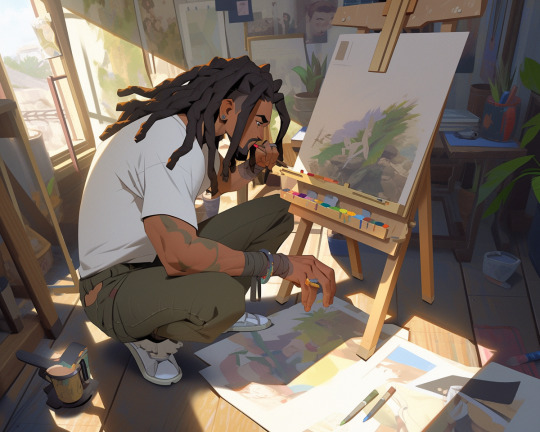


. "Traditional Works" "AI Works"
Please Read the Room.
"Crafted with Passion, Shaped by Imagination"
Welcome to Verum Artifex, where creativity meets innovation. Dive into a world where traditional artistry blends seamlessly with cutting-edge technology. Here, the human spirit of creativity is the driving force, and AI is a tool that enhances our abilities, not a replacement for them. Join us on this journey and discover the limitless possibilities of design and illustration.
Socials:
Twitter
Instagram
Youtube
LinkedIn
Tumblr
Website
Merch / Prints
Design Consultation
FAQS:
What is Verum Artifex?
"Verum Artifex" means "True Artist" in Latin. Verum Artifex is an online portfolio of a talented Designer, Illustrator, and Artist based in the washington DC metro area. The website showcases the artist’s work and offers a cariety of design services tailored to meet the unique need of clients. I want to help people tap into their potential as an artist, and insprire people wirh great visuals.
"Crafted with Passion, Shaped by Imagination"
What type of work do you do?
I specialize in digital illustration, creative design, branding services, graphic design, portraits, conceptualizations and ai generations.
When did you start making Art & Design, and whats your background?
As a child, I was fascinated with creativity, and the idea of the production of "Good Works", I adored experiencing art and developing my eye for good design, so much so that I naturally decided to make it my profession. I have been a visual artist for the past 10 years.
What Programs do you use?
Adobe Creative Suite, Midjourney, Procreate, Adobe Illustrator
Do you utilize AI into your work flow?
Yes, I am a traditional digital designer who also started to incorporate Artificial Intelligence into my workflow. With over a decade of experience in art and design through self-taught and traditional mediums, I began adopting AI at the start of 2023. Currently, I am in the discovery phase of this technology. I practice with it every day and will soon transition to a more transformative approach, incorporating my traditional abilities with this new phenomenon. It's important to note that while AI is a powerful tool, it doesn't replace the human creativity, thought, and decision-making that goes into each piece of art. Each design is a result of a human-led process, with AI serving as a tool to enhance and expand the creative possibilities. I firmly believe in respecting the rights and efforts of human artists. This includes not using someone else's work without permission, and giving credit where it's due. I am committed to using AI responsibly and ethically in my art.
However, despite its growing popularity, AI art is often misunderstood and underestimated. In this article, we will address the misconceptions surrounding AI art and highlight how it can enhance the skills of great artists and designers.
Unveiling the Misconceptions Surrounding AI Art and Its Potential for Advancing the Great Artist/Designer
Are your commissions open?
Yes, I am currently accepting commissions. If you have a vision or an idea that you'd like to bring to life, I would be glad to help you realize it. Whether it's a project, a gift, or a branding effort for your business, I'm here to provide a unique, creative solution that meets your needs. Don't hesitate to reach out with your ideas, and let's create something beautiful together. Contact me today and let's start the journey of turning your vision into reality.
#designer#artist#artist on tumblr#illustration#digital illustration#aestheitcs#black artist#ai artist#visual design
12 notes
·
View notes
Text

Solo Traveler's Dubai Diaries: Uncovering the Best Travel Packages & Tips-Tricks
Exploring Dubai Solo: A Wanderer's Paradise
Welcome, fellow solo travelers, to the vibrant city of Dubai! In this guide, we'll unravel the best travel packages tailored just for independent explorers like you. From safe accommodations to thrilling group tours and insider travel tips and tricks, get ready to embark on an unforgettable journey through the dazzling emirate of Dubai.
Safe Sanctuaries: Accommodation Options
Dubai understands the unique needs of solo travelers, offering a range of accommodation options that prioritize safety, comfort, and convenience. Whether you prefer the social atmosphere of hostels or the privacy of solo traveler-friendly hotels, Dubai has something for everyone. Consider staying in areas like Downtown Dubai, Dubai Marina, or Jumeirah Beach Residence for easy access to attractions and a vibrant nightlife scene.
Group Tours Galore: Joining Fellow Explorers
Solo travel doesn't mean you have to explore Dubai alone. Joining group tours is a fantastic way to discover the city's highlights while connecting with fellow travelers. Opt for a desert safari adventure where you can ride camels, try sandboarding, and watch a mesmerizing sunset over the dunes. Alternatively, explore Dubai's cultural heritage with a guided tour of historic sites like the Al Fahidi Historic District and the Dubai Museum.
Networking Events for Solo Explorers
Dubai's bustling social scene offers numerous opportunities for solo travelers to meet new people and forge meaningful connections. Keep an eye out for networking events, workshops, and social gatherings tailored for travelers. Platforms like Meetup and Eventbrite often list upcoming events where you can mingle with locals and fellow adventurers, share travel tips, and perhaps even find a travel buddy for your next adventure.
Navigating Dubai Like a Pro: Insider Tips for Solo Explorers
Navigating Dubai may seem daunting at first, but with a few insider tips, you'll navigate the city like a pro. Invest in a rechargeable No l Card for hassle-free access to public transportation, including the metro, buses, and water taxis. Familiarize yourself with Dubai's cultural norms, such as dressing modestly in public places and respecting local customs during Ramadan. For hidden gems and off-the-beaten-path experiences, explore neighbourhoods like Al Quoz for its vibrant arts scene or Alserkal Avenue for galleries, cafes, and boutiques.
Embracing Solo Freedom: Customized Solo Travel Packages
If you crave a personalized solo travel experience, consider booking a customized solo travel packages designed specifically for independent explorers. These packages often include a mix of guided tours and free time to explore at your own pace. Choose from themed itineraries like adventure travel, wellness retreats, or foodie experiences tailored to your interests. Many tour operators also offer solo-friendly accommodations and activities, ensuring you have a seamless and enjoyable solo adventure in Dubai.
Solo Adventure Awaits
Dubai is a city of contrasts, where modern skyscrapers coexist with ancient traditions, offering solo travelers a rich tapestry of experiences to uncover. With the best travel packages designed for independent explorers, safe accommodations, exciting group tours, networking events, insider tips, and customized experiences, Dubai is indeed a wanderer's paradise. So, pack your bags, embrace the solo freedom, and get ready for an unforgettable adventure in the heart of the Middle East!
#SoloTravel#DubaiAdventure#TravelPackages#Wanderlust#ExploreDubai#SoloExplorer#TravelTips#NetworkingEvents#SafeAccommodation#GroupTours
2 notes
·
View notes
Text
Rubell Museum - DC - Jan 13 2024
A trip to the Rubell Museum was something to look forward to despite my new Doc Martens slicing up my ankles during my 10-minute walk from the Waterfront Metro station. Opened on Oct 29th, 2022, the DC location at 65 I St. SW brought Mera and Don Rubell's collection of post-1980 art from Miami to the DC's Southwest neighborhood. This would be my second time visiting with my first experience viewing the inaugural exhibition What's Going On?. The collection showcased many artists I was not familiar with. It was a treat discovering new and exciting art. For me, artists that I wanted to learn more about from my last visit were Chase Hall, Hernan Bas and Christina Quarles.

Christina Quarles
Detail: Fell to Earth (Felt to Pieces), 2018
Acrylic on Canvas
Taking advantage of the gorgeous and expansive space past the entrance, the museum mounted works by Alexandre Diop - a Franco-Senegalese artist who, according to the website, "uses discarded objects to create work that raises questions pertaining to sociopolitical, cultural and gender issues. Drawing inspiration from his European and African roots, he explores the legacies of colonialism and diaspora while tackling universal themes of ancestry, suffering, and historical violence". The open space with its large cathedral-esque windows floods the space with natural light, showcasing all the wonderful varied textures and highlighting all the materials that Diop uses in his work.

Once you exit this room, you will enter a three-level building that was once part of Randall Junior High School, a historically Black public school that ceased operations in 1978. The Rubells purchased this historic site from the Corcoran College of Art and Design in 2010 for $6.5 million. The building was the site for the inaugural What's Going On? when the museum opened in 2022.
Although quite disorienting to navigate at first, each level essentially follows a radial floor plan. There will be an exhibit in the middle of the level when you first come, and then out in all directions are hallways that will lead to individual rooms with their own exhibits relating to the overall current exhibition - Singular Views: 25 Artists.
One of the biggest flaws in the architecture of the building or more importantly, how the architecture is utilized, is the decision to install art in the narrow hallways. These hallways doubtfully will pass the modern fire and safety code. Large enough to fit one individual through, there would often be two-dimensional works hanging on both sides of the wall. The proximity between the visitors and the works would make any conservator nervous. There is a serious bottleneck where a visitor must wait for another to pass through before entering these spaces. Needless to say, when there is a person waiting, one cannot help but exit in a hurried manner. This takes away any chance for close looking or truly connecting and appreciating the work.
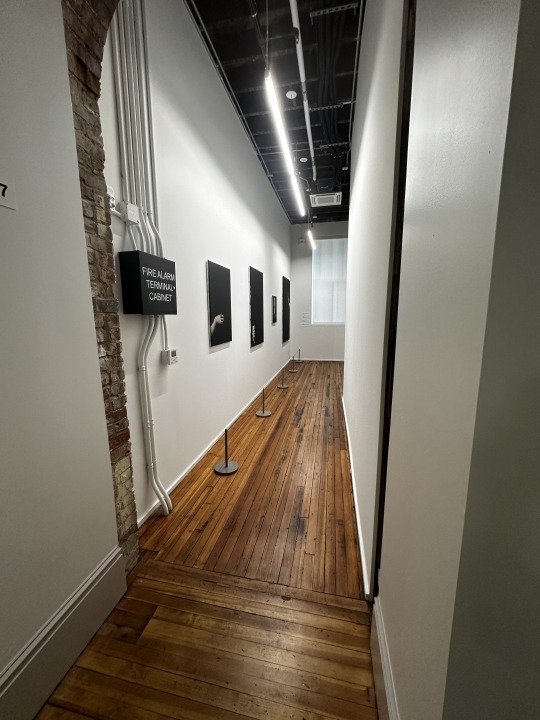
Overall, the exhibition was something you would come to expect of the Rubell Museum (so far that I have seen in DC): colorful, vibrant, electric and featuring young artists, some in their early or mid careers. The standouts this time for me were Amoako Boafo, Otis Kwame Kye Quaicoe and Rozeal, whom I will be covering in separate posts so they each have their own spotlights.
3 notes
·
View notes
Text
REVIEWING THE CHARTS: 10/02/2024
Noah Kahan’s “Stick Season” is still #1, it’s a short episode, you really probably should skip it - there's nothing of value discussed here... welcome back to REVIEWING THE CHARTS.

Rundown
This is not a good week. You could call it a stale week, it’s probably accurate, because there’s not much of interest and what is here is mostly utter garbage. Potentially, up there with the worst weeks ever in terms of new arrivals to the UK Top 75, which is what I cover, and speaking of what I cover, notable dropouts are songs exiting said top 75 after five weeks in the region or a peak in the top 40, and this week, we bid adieu to: “Skin and Bones” by David Kushner, “neé-nah” by 21 Savage, Travis Scott and Metro Boomin, “Practice” by Drake, “Pink Friday Girls” and “Everybody” featuring Lil Uzi Vert by Nicki Minaj and finally, “Paint the Town Red” by Doja Cat. One highlight of this dire week is that I’m not really complaining about any of that.
Lewis Capaldi’s “Someone You Loved” returns to #67, what a joy, as well as “Anti-Hero” by Taylor Swift at #62 and “Flowers” by Miley Cyrus at #51. Can’t help but think the GRAMMYs had some influence on these. As for notable gains, we see boosts for Taylor’s “Is it Over Now?” at #68, “MY EYES” by Travis Scott at #65, “What Was I Made For?” by Billie Eilish at #58, “Would You (go to bed with me?)” by Campbell and Alcemist at #52, “Perfect (Exceeder)” by Mason vs. Princess Superstar at #39, “Runaway” by Ye featuring Pusha T at #35, seemingly because well, there may or may not be an album coming because that’s what we needed: more discourse. Then we have “Scared to Start” by Michael Marcagi at #31, “Selfish” by Justin Timberlake at #29 (why are we doing this?), “exes” by Tate McRae at #23, “Alibi” by Ella Henderson featuring Rudimental at #16 (Christ), and we end with two positives at least, as YG Marley and Benson Boone both get their first top 10s with pretty damn good songs, in my opinion: “Praise Jah in the Moonlight” at #9 and “Beautiful Things” at #5, which brings us to that top five, which is otherwise completely the same as last week. Jack Harlow’s at #4, Teddy Swims at #3, Sophie Ellis-Bextor at #2 and for a sixth week, Noah Kahan at #1. You know the song names off by heart by now, and I need some time to let off a deep sigh before rattling off the new songs. Oh, boy, the new songs.
New Entries
#75 - “Out for Love” - Andrew Underberg, Sam Haft and Daphne Rubin-Vega
Produced by Andrew Underberg and Sam Haft
So, Hazbin Hotel was a web pilot by Vivienne Medrano or “ViziePop” that was later picked up by Amazon as a television series this year. It is a musical animated series hence has several soundtrack singles, and given the weak charts and viral nature of the show, some of them have ended up here. I watched the pilot and first four episodes of the series, and found it genuinely quite difficult to stomach - I love adult animation, I love musicals, I actually even like the art style - it was the narrative elements of the show that killed it for me, and this is not a TV review blog, it’s a music review blog. I knew at least one song would debut as the midweek update showed one song at #73, I figured that would be the only song and it could potentially not even appear, so I wrote a very tersely-worded review for that song in particular. It’s a bit… not all that useful anymore, for lack of a better phrase. So I’m largely not going to be covering these. This is from the seventh episode, which I haven’t seen. Song doesn’t make any Goddamn sense to me. Journalism.
#74 - “Thank You (Not So Bad)” - Dimitri Vegas & Like Mike, Tiesto, Dido and W&W
Produced by Dimitri Vegas & Like Mike, Tiesto, W&W, Bassjackers and Renze Michels
Okay, if you’re going to credit a grand total of five EDM producers, why not go the full mile and have all eight pick out a lead? Also, I would ask how eight people were involved in producing this if I had any doubts that it wasn’t just an uncredited guy who got paid to sell this lazy sample flip off to people with actual star power. A sample flip of what, you may ask? Sigh… well, if there’s anything vaguely positive I can say about “Alibi” is that it’s influential. This is somehow even lazier, however, so I guess let’s start with some kind of history.
First of all, Dido’s “Thank You” is a perfectly fine, honest song that peaked at #3 in 2001 - “Do You Really Like It?” by DJ Pied Piper & the Masters of Ceremonies rightfully took #1 that week - and whilst I’ve never been a big fan, I can definitely see why the melancholy downtempo ballad resonates with people, and on a bad day, I can definitely throw this on and feel a little hope. This is a bad chart day, and if “Thank You” were to chart in its original form, it could perhaps be a reminder that things are, despite everything, it’s not so bad. So I imagine rap fans will know one of if not both of the uses of this song in popular hip hop, the first being Eminem’s classic “Stan”, probably my second favourite of his. It actually did #1 for one week in 2000, before the original had charted. It’s a stark and incredibly clever recontextualisation of the song that I’m pretty sure has already been discussed as much as possible, there’s a reason why many consider it Em’s crowning moment. Rae Sremmurd, “Lean’s Gone Cold”… maybe not so much. That one didn’t chart, but it’s funny.
Now there is precedent for house remixes of “Thank You”, and whilst I’m willing to consider interpretations and reimaginings of practically any song as any different style, I feel like making “Thank You” more danceable than just a vague nodding of the head skews some of the narrative’s tone? It definitely makes for a weirder, more dissonant listen, and whilst the Deep Dish remix, actually a GRAMMY Award-winning remix, does its best to maintain the atmosphere in its nine minutes, turning “not so bad” into a faint, looping mantra under a constantly developing house groove, to the point where it is a genuinely pretty great house song production wise… it still doesn’t feel like a great adaptation of “Thank You”, just a different product entirely, which makes sense and honestly makes for a better song. It doesn’t try and be “Thank You”, despite not even registering itself as an original song, just a remix of the original still credited solely to Dido. In 2016, European electro house duos Dimitri Vegas & Like Mike and W&W made a song called “Arcade”, it’s a loud, compressed smorgasboard of cheap synth sounds made for a live festival setting and being practically unlistenable outside of that context. In 2020, German producers Felix Jaehn and VIZE made a much more conventional and, at least in terms of how much it cribs from the original, a more faithful rendition of “Thank You”, subtitled “Not So Bad”. It’s a flavourless tropical house riff that I think the world would be better off not hearing, it’s like “Thank You” by Dido if she was commissioned to make it by an advertising company looking for a soundtrack to gym commercials.
Somewhere across the line, I guess it must have been Tiesto who said, “What if we made a version of that Felix Jaehn song but basically in the soundfont of “Arcade”?” - the latter even being directly listed as a sample on Genius. I mean, otherwise, I don’t know what the Hell Tiesto is doing here but, generally, you have to be shitting me, right? This is two minutes and 20 seconds constructed out of bits and pieces of songs I may not like but had a lot more purposeful artistic intent to them, if that’s a correct way of phrasing it. This is a vaguely functional crap-shoot molded from genuine song ideas, starting with a gentle singer-songwriter track that actually means a Hell of a lot to millions of people. I’d believe that to many fans, that Rae Sremmurd rendition means a lot to them. What does this mean to anybody?
#63 - “Bandit” - Don Toliver
Produced by ReidMD
I don’t like Don Toliver, really, or Tame Impala for that record, but there’s a level of inherent quality here, right? Don can sing, Tame Impala can construct a vibe and the sample here is “One More Hour” from their 2020 album The Slow Rush, it’s completely serviceable, could make for a good song. So why the sample is rendered in such low quality screeching is beyond me, but hey, maybe a powerful beat could work? Oh, the trap skitter is not only completely rote and overdone, it’s really high in the mix and distracts from the bass, which could really help make this song work? Okay, well, what’s Don doing? Being basically a cartoon character with his flows and incessant ad-libs? Well, that could be fun - oh, he’s comparing himself to Marilyn Manson? Barely rhyming? Catching a good, intense flow only to mumble repeated lines mostly about having sex that make up much of the song, with a tiny verse in the middle? Well, maybe the outro can make up for it - oh, he’s doing a Cookie Monster impression. Welp, all hope is lost.
#55 - “Poison” - Blake Roman, Sam Haft and Andrew Underberg
Produced by Sam Haft and Andrew Underberg
This is an upbeat synthpop jam that soundtracks a sex slavery montage. It sounds like a song by The Weeknd covered by a SpongeBob AI voice model. Next.
#53 - “Loser, Baby” - Andrew Underberg, Sam Haft, Keith David and Blake Roman
Produced by Sam Haft and Andrew Underberg
This was the song that made me turn the fourth episode off in disgust. I had a massive review prepared, covering its treatment of sexual abuse, which probably gave it a higher degree of nuance and generosity than many others are willing to give it, but I’m not compelled to rant about cartoons in this series. I want to write about animation more often but preferably animation I like or actually find compelling. With all respect to those who enjoy it and power to them, Hazbin Hotel was not something I would like to grant any more attention than the brief necessity of my format. Thanks for understanding.
#40 - “Home” - Good Neighbours
Produced by Good Scott and Oli Fox
I was very much willing to give this one a good shake because, I mean, what else do we have? Scott and Fox teased this on TikTok months prior before releasijng this as their official debut single together, after malformed, quickly aborted solo runs a few years ago. Sounds like a recipe for chart success and oh, the song’s terrible. It has a whistle about as charming as the American Authors’ milennial whoops, really insufferably screeching vocal tones that remind me of Passion Pit more than anything - that isn’t really a good thing - and sentimental lyrics about what home means to him, which would be completely serviceable without the stiff, grooveless splodge of grey matter that calls itself a chorus. Oh, and you know those sentimental lyrics? They’re gone by this point, it’s an incredibly manipulative breakup song with some really gross attempts at poetry - “wrap my name across your mouth when I let my feelings down”? Ew, man, Charlie Puth is less contrived than this. Naturally, the song goes nowhere and sadly, that probably won’t be its chart trajectory. Yet, once again, this song is practically unlistenable.
Conclusion
…Don Toliver gets Best of the Week. Somehow. Thanks for reading, I guess? See you next whenever.
2 notes
·
View notes
Note
HI EM! okok 1, 2, and 4 for the end of the year asks? (you know me- i see anything to do with music and i pounce)
HEY BLU okay okay so:
1 - song of the year
i think it HAS to be The Fear by The Ruen Brothers 🌙🌵🖤 it was the song that made me fall in love with them, the song that got me through a really horrible last winter, the song that made me feel less alone in feeling afraid and anxious. i am so in love with it!!
2 - album of the year
so i listened to First Two Pages of Frankenstein by The National so hard these last few months!!! it came out in april and its just brilliant start to finish!! so rarely do i come across what feels like a perfect album, but this absolutely is that for me.
highlights include: once upon a poolside (which also is SO austria!winnix coded, just think once upon a lakeside and cry a lot), eucalyptus (there's a line that says "what about the rainbow eucalyptus?" that always makes me go...yeah...what ABOUT the rainbow eucalyptus??), and ice machines (this was a dark horse fav for me, one that i fell in love with after a few listens and now im OBSESSED)
anyways, would highly highly recommend!!!
4 - movie of the year
look the best movie to come out this year imho was across the spiderverse?? i fucking LOVED into the spiderverse when it came out, and i had been looking forward to it so much and you know what?? it DELIVERED. the art the music the characters the fucking ENDING??? i cannot WAIT for the third one, i love miles morales so hard, i love gwen SO HARD, i want to be best friends with hobie, i have so many fucking theories about what the fuck is up with miguel, FUCK I LOVE THIS MOVIE!!
(to keep up the theme of the other questions, fav song from the soundtrack is am i dreaming!!)
thank you so much for asking blu!!! i hope you enjoy!!!
questions from the end of year ask game here
2 notes
·
View notes
Note
Do you have any favorite looks for Koshiko and Nakata? Like photos where you particularly liked their fashion or styling?
So many examples that writing a response to this simple question nearly drove me insane for several days lmao. One of capsule's biggest "selling" points for me was that they mostly wore their own clothes for photoshoots, MVs, performances etc and Nakata largely handled styling and whatnot. (Also probably one of the reasons that Metro Pulse landed disastrously with me, I don't want to see polygonal character models fighting to the death, I want you two to serve looks 😭)
Where Toshiko's concerned, I usually loved her outfits at the annual festivals they'd do like Rock in Japan and Countdown:
2010 RIJ FES fit is legendary
I honestly feel like this houndstooth configuration that appeared at CDJ 2012 altered my brain chemistry in some way. I can see it being a bit too "circus" or costume-y for some, the bi-color tights are definitely going a little overboard, but I still think about it all these years later (take a closer look at the heels she wore too).
2014 Summer Sonic, I like to call this the angel look; there's a pattern here with me liking these dresses/skirts with strange construction lol
Big fan of the OTONOKO 2018 sparkly tulle dress (may be a top + skirt combo, either way). It was extremely whimsical, looked beautiful on a stage environment, and I love the idea of Toshiko as a pinch of the night sky placed down on earth. (I like it so much you can have another photo of it here)
At their last Countdown appearance in 2019 she wore this draped dress; the blunt lob haircut really elevated the maturity of the whole look (I think some low denier tights would've made this even crazier).
Thigh-high boots go brrr (starting to wonder if I just really liked this wig a lot)
Special mention to this sequin dress, she is nothing short of a genius for wearing those nylons with it and Nakata was wrong for saying she looked like a fish lmao
I do actually like her simpler stage outfits like this gold babydoll dress. Her headwear is unparalleled, I can't imagine how many hats/hair accessories she owns...
Lastly her WAVE RUNNER tour encore look was just cute and nicely coordinated for being so simple; I also adore the way their shoes matched here but I lose my mind whenever they match their outfits at all…
In general I love how consistent she is in her style, it's very elegant and feminine overall but she likes to do these unusual silhouettes and whimsical accessories that have a lot of drama to them. This is my favorite example of her fashion outside of performances; my list highlighted major appearances where you'd expect her to go full theatrical but even her regular day-to-day outfits are nice, often simple but never boring.
Moving along...
Generally speaking Nakata has a great eye for individual pieces rather than excelling at putting together well-coordinated outfits (on himself at least, I loved the times he styled Toshiko). He's also the living embodiment of the shorts-wearing NPC trainer in Pokemon lmao. Like he's definitely shown the potential to Dress over the years and I'd actually love to see him do styling work on other people again (also would love to see art direction from him again, design, etc etc anyway :^)), he has a very particular aesthetic sense that I always enjoyed, but overall he seems to prize comfort and especially after 2016 you can see his style get increasingly...utilitarian? Unembellished? Honestly there was a video I saw by some YouTuber who attempted to discuss Nakata's style and all they had to go off was his Instagram and their conclusion was "he likes to wear his own logo a lot;" it's an understatement to say that made me die a little inside, lol (not the tuber's fault of course).
I tried to pinpoint specific ~whole outfits but it's kind of difficult, as a result the majority of these are from magazine shoots:
2007 Sugarless GiRL for MARQUEE - I've been obsessed with this since forever but I'm not even sure how to explain it... It's a wintry, boyish sort of look, the overalls were very flattering, the shoes are cute, and that scarf was actually really interesting because it had these weird hand pockets (you can see them in this photo). I'd kill to see more takes from any of their magazine shoots but especially this one.
2005 LDK event covered in CUTiE magazine - I think everyone loves this one lmao, whoever did Nakata's hair is a god. It's a great inbetween style from LDK to FRUITS CLiPPER; it's very interesting the way he sort of found his fashion "voice" the same time he found his musical one for capsule.
Speaking of which, 2006 FRUITS CLiPPER artist profile shoot (well, this is from MARQUEE, but he wore the same thing for their artist pics) - the black-white-gray layered look might be my favorite example of his ~eye for coordinating clothes or whatever you wanna call it lol. Love that C necklace too, he only really wore it during '06 though and was never much for necklaces in general (I think it's funny one of the few remaining pics on his Insta is this one). Blazers are notoriously tricky to wear without seeming like you're stuffy and/or going to the office, he somehow always pulled them off really well...
2007 capsule rmx for MARQUEE - another that seems unanimously loved. I liked that headscarf he's wearing so much that I bought the same one (not a single clue how to style/pull it off though)
2007 FLASH BACK for MARQUEE - love the long zip-up jacket with the fur-trim hood, love those iconic yellow Belly Button boots (yes, that's really the brand name)
Getting away from MARQUEE, I just posted these but his outfit for S&R was actually kinda good? I do wanna beat him over the head for wearing shorts to meet Sakamoto Ryuichi but it's a cute look and I think he was smart to wear the brown frames instead of his black ones as they would've been too harsh. The detailing on the shirt and shorts goes perfectly, while I don't like high-top shoes on him in a broad sense these had cute contrasting laces and I like their suede look. More accessorizing with jewelry would've been great here but at that point (2012) he put away pretty much everything apart from the watches...
self vol. 1 (spring 2009) - this one doesn't go like super crazy or anything but I think it's cute and nicely put-together, here's another picture of it in better/natural lighting. Really like that T-shirt from FRAPBOIS
2013 CAPS LOCK - you could say this is pretty boring compared to the other examples here but I reeeally liked the weird keycap rings(?) and the not-insignificant heels on his oxfords lol. The fact that these are capris and not full-length pants also keeps it from being too stuffy and basic. (And once again wearing the same color for the top + bottom makes this sort of "seamless" look that in turn helps create an illusion of proportionality.)
2015 Downtown appearance - and now I'm going to throw all fashion rules about proportions/looking ~taller out the window because I loved this lmaooo, peak comfy outfit and makes me want to buy an oversized white hoodie so bad (I haven't said it yet but I think white might be his best color). Also I'm pretty sure his hair was professionally done here, it looked great.
Also 2015, the Keith Haring print sweatshirt over a button-up
Since I'm nuts I'm gonna keep blathering but now about specific pieces he's worn that I really liked (not a complete list by any means, just what comes to mind right now):
This baseball cap with the half of a stag rising out of it, he's f*cking crazy I swear to god (naturally he wore this because they shot these pics at Hanjiro which was a clothing store with a particular sense of décor)
Bomber jacket at ageHa last year, I love stuff like this with that sort of mirror-like sheen (it's kind of iridescent but not quite) and the cut/style of it was good
I think way too often about this reversible jacket he wore on a karaoke date with Kyary. Up to that point I'd just seen him wearing logos and boring all-black semi-athleisure stuff for years so this was a pretty crazy statement piece
Speaking of random pieces that live rent-free in my head, I really want to know the brand of this sweatshirt from the 2019 album announcement, it's sooo weird and just, like, interesting
The blazer for WAVE RUNNER was shockingly cute, no comment on the rest of the fit or the wonky Photoshopping though (god their artist photos are so hit-or-miss)
The Jeremy Scott F/W 2007 hoodie of course
Studded bowtie
Uniqlo crossword puzzle shirt
Not the best possible pic of this but I like this shirt with the studded suspenders detail, he wore this to RIJ FES one year
Do headphones count? Headphones count, this is my favorite pair he ever had
This jacket is one of my favorites of his, I wanted the same one so badly for so many years lmao
Honestly there's so much that I'm exhausted writing this list, I'm gonna stop with these pants and leave it at that
His style at its best is just kind of quirky, very very playful, obviously keeps to a grayscale palette but he has some surprisingly colorful pieces. His taste in jewelry was pretty awesome too, he had some interesting rings I was a big fan of but I'm too lazy to go find pics (there was a Hello Kitty one, a giant star, a cow's head...).
In conclusion I think they share a lot of similarities in their style and I would kill for either of them to have ever released a ~style book (sadly the timing for that has long passed and the demand was probably nonexistent in the first place). Some people also may be wondering why I completely ignored their looks from pre-2006/the future pop neo whatever era and the simple answer is...IDK, it's not that I hated their styling back then (well, it was pretty rough sometimes), it was just more costume-y and as a result sort of inauthentic in a sense. They were also frequently styled by other people during that time; their own personal style and/or Nakata's styling had a much greater impact on my teenaged brain as far as influencing my tastes. But Toshiko wore the '60s silhouette and boyish sort of hairstyles extremely well and the contemode hair/makeup girlie Miyagawa Tomoko always did a fantastic job.
Whoever actually read this far is clearly very interested in this topic so if you want to feel free to message me your own favorite capsule outfits and whatnot. I know Toshiko particularly had some crazy colorful/weird dresses she's worn in the past that I didn't mention here lol
8 notes
·
View notes